Ananda
Mandir
269 Cedar Grove Lane
Somerset, NJ 08873
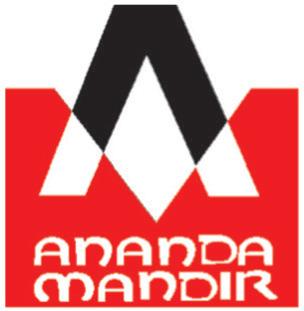

Ananda
Mandir
269 Cedar Grove Lane
Somerset, NJ 08873

By Pradip R. Das (New Jersey)
Philanthropy, meaning “love of humankind”, has roots stretching back to ancient Greece, with the word itself derived from the Greek “phil” (loving) and “anthropos” (humankind). Ancient Greece saw elites supporting public endeavors with private funds, and the concept also appears in Greek plays. Over time, philanthropy evolved, with different cultures and religions contributing their own forms of charitable giving. In the United States, philanthropy has played a significant role in funding various sectors, including education, healthcare, science and the arts, often intertwined with social movements and geopolitical conflicts. (Volumes can be written if one has to chronicle the growth and spread of philanthropy through the different ages of mankind, various civilizations, and different religions. However, the author will focus on the evolution of philanthropy in America, which in itself embodies an enormous body of information and history.
The earliest traceable philanthropic organization in the US was the Peabody Education Fund, whose mission was to improve education in the post-Civil War South, particularly for poor white communities and formerly enslaved individuals. While the Emancipation Proclamation had legally ended slavery in America, deep racial and economic inequalities remained, particularly in access to education.
The post-Civil War era saw the beginning of philanthropic giving in America, which started as fragmented efforts by religious groups in almsgiving and volunteerism and aimed at alleviating immediate problems of the urban poor. As America began to recover from the Civil War, industrialization and the rise of “modern” philanthropy took shape. The booming factory economy and its rapid growth had its costs. The wealth gap between the industrial capitalists and the working class widened drastically. Factory conditions were usually dangerous and inhumane. Low wages, long hours, and child labor were common. The influx of people into urban centers brought associated problems of overcrowded housing, widespread poverty, and unsafe working conditions. As a consequence, a new wave of nonprofit organizations arose to address these urgent social and economic needs. Thus, the foundation of modern social services was laid, offering aid and advocacy in a rapidly changing and evolving America.
The end of the 19th century witnessed massive industrialization and rise of modern philanthropy in the country. Management methods geared to modern grant-making took form, founded on the large-scale donations of several individuals and families who had amassed immense wealth spanning the late 19th and early 20th centuries in the steel, oil, railroad, telegraph and automobile industries. Names such as Carnegie, Rockefeller, Ford and Sage conspicuously stand out, not only in America but the world over.
Andrew Carnegie amassed immense wealth through the steel industry during the Industrial Revolution. Although his mills were notorious for demanding twelve-hour shifts and seven-day work under hazardous conditions. Despite his labor record, Carnegie is still recognized as one of the first modern philanthropists. Based on the belief that wealth should be used to uplift society, he primarily focused on education, particularly through the establishment of free libraries. When public libraries were rare, he championed the idea that everyone, irrespective of class, should have access to books and learning. There were few public libraries in the world then. So, beginning in 1881, Carnegie and his charitable foundation invested more than $56 million to construct 2509 libraries across the English-speaking world, thereby fundamentally transforming access to education for generations to come. In his book, “The Gospel of Wealth”, Carnegie emphasized that wealth should be used to uplift the lives of the less fortunate and that “The man who dies thus rich, dies disgraced”.
As impactful as they were, these philanthropic efforts came with problematic caveats. Although these wealthy donors agreed that the benefits should go to lower-income and vulnerable populations, they often could not agree on who was worthy of that support. Quoting from Carnegie’s book The Gospel of Wealth, “It was better for mankind that the millions of the rich were thrown into the seas than so spent as to encourage the slothful, the drunken, the unworthy”. This mindset continues to prevail among today’s non-profit leaders and charitable organizations, giving wealthy donors disproportionate control over the allocation of resources, allowing them to decide who is deserving of help based on their own values, instead of serving the actual needs of the communities. This often took away the power of communities to advocate for themselves
or influence the support they actually needed. Nevertheless, Carnegie paved the way for fostering the culture that is the basis of modern philanthropy. and the foundations built by these industrial titans had a lasting impact in fields such as education, science, public health and the arts. This eventually also signaled the growth of grassroots fundraising and the democratization of giving; it was no longer concentrated on the elite, wealthy individuals who gave but focused on average individuals and families.
The 20th century witnessed the emergence of the community foundation movement, a combination of the rising forces of scientific philanthropy, grant-making foundations, and collective giving. Community foundations helped people of modest wealth to pool their money for local philanthropic programs. Giving was also encouraged by the 1971 passage of legislation that allowed Americans to take tax deductions for their charitable gifts and as a way to avoid the personal income tax laws promulgated four years later.
Early philanthropy in America was largely driven by wealthy individuals and private foundations but the Great Depression marked a major turning point in the history of non-profits, transferring the responsibility of social welfare more directly on the federal government. As a rejoinder to this, President Franklin D. Roosevelt initiated the New Deal, a sweeping set of programs to provide relief to working-class and low-income Americans. During the tenure of his first presidency, FDR passed a series of bills aimed at lifting the country out of crisis. Among these initiatives were the Civilian Conservation Corps, an initiative to employ young men in rural and park development, the National Labor Relations Act, and the creation of Social Security. The landscape of nonprofit and philanthropic work in America was significantly reshaped as a result of these policies.
As the New Deal redefined the government’s role in social welfare, the global crises that followed further expanded the significance and scope of nonprofits. Both World Wars had significant impacts on charitable giving, shifting its scale and objectives. During those turbulent and uncertain times, nonprofit efforts were centered around medical care, food distribution and psychological support. World War II, in particular, focused on the global importance and relevance of nonprofit work, as mil-
continue to page 15 }
Ananda Mandir
Calendar of Events (Dates are subject to Change) Please check our website frequently www.anandamandir.org Tel: 732-873-9821
NOTE: For Puja time please contact temple or visit our website: anandamandir.org
OCTOBER 2025
Maha Nabomi, Wednesday, October 1
Bijoya Dashomi, Thursday, October 2
Kojagori Lakshmi Puja, Monday, October 6
Satyanarayna Puja, Monday, October 6
MahaKali Puja, Monday, October 20
Jagaddhatri Puja, Thursday, October 30
NOVEMBER 2025
Ras Purnima, Wednesday, November 5
Satyanarayna Puja, Wednesday, November 5
Shyama Puja, Wednesday, November 19
DECEMBER 2025
Satyanarayana Puja, Sunday, December 7
Shyama Puja, Friday, December19
JANUARY 2026
Satyanarayan Puja, Thursday, January 1
Ratanti Kalika Puja, Saturday, January 17
Shyama Puja, Sunday, January 18
Saraswati Puja, Friday, January 23
(*) See www.anandamandir.org or Call Mandir for details
Special Religious Services: Upon request, the priest of Ananda Mandir offers services such as in-house Shraddhas, Rituals associated with Cremations (Antyesti Kriya), Shraddha Anniversaries, Pre-wedding rituals (Naandimukh, Ashirwad, etc.), Upanayan (Paitey), Annaprasan, Wedding Ceremonies & Wedding Anniversaries, Griha Prabesh (Bhumi Puja), Consecrations of new cars (New Car Pujas) and others. If you have needs for any of the above or more, please feel free to contact Biswabhai @ 732-873-9821
Dear Editor,
A Periodical Newsletter Published By ANANDA
MANDIR
(A Tax-Exempt, Non-Profit Organization)
269 Cedar Grove Lane Somerset, NJ 08873
Phone: 732-873-9821
Website: www.anandamandir.0rg ***
Debajyoti Chatterji Executive Editor (Acting)
All queries, articles, news reports and letters should be directed to debsmees572@gmail.com Phone: 908-507-9640
For general information, please contact the following executives of Ananda Mandir: Anjan Lahiri President
Jai Prakash Biswas Vice President
Debajyoti Chatterji Vice President
Ashok Rakhit Vice President
Arun Bhowmik General Secretary
Sanchoy Das Treasurer
Pradip Majumdar Assistant Treasurer
BECOME A MEMBER OF ANANDA MANDIR AND PARTICIPATE IN THE COMMUNITY ACTIVITIES TO ENRICH YOUR FAMILY
In the excellent article “Who holds the key to a meaningful truce between India and Pakistan”, the author has provided a good historical review of the politics between the two countries since India’s independence.The title question, however, is dealt with only in the last paragraph, and the postulated solution, in my opinion, is impractical and improbable.
Russia and China are only united because of their common enemy, the USA. They have never demonstrated a common, meaningful and united foreign policy, BRICS notwithstanding. China’s foreign policy is totally focused on replacing the USA as the world’s leading superpower, as evidenced by its Belt and Road initiative, financing of the many investments in many countries, particularly in Africa and Asia. Pakistan is their key ally in South Asia, and financing and arming that country is a priority for them. Disincentivizing Pakistan to stop terrorizing India, which China looks upon as an enemy, would be contrary to its interests. Russia needs India as an ally to counter the USA. India has been, over the last decade, slowly moving to a closer trade and military relationship with the USA, and Russia would want to stop this move. The last thing Russia would want is to settle the longstanding problem between the two countries, so India could focus on its relationship with the US. No, it is India that holds the key to the conflict by becoming an economic powerhouse and by modernizing its conventional and nuclear military capabilities, including a ballistic delivery system that can reach Beijing. No country, including Pakistan, would then want to mess with it.
Ranajit Mitra New Jersey
Reported by: Shreya Choudhury
On Friday, August 15, Ananda Mandir celebrated its annual Heritage Day with a vibrant display of patriotism, culture and community spirit. The morning began with a lively procession, as the crowd chanted, “Vande Mataram,” led by our priest,Bishwabhai. Upon reaching the flagpole, we paused to honor the sacrifices of those who gave their lives for India’s freedom. The flag hoisting ceremony was followed by solemn singing of“Jana Gana Mana,” accompanied instrumentally by Soujattyo and led vocally by Shreya, with everyone joining in. Afterward, Anaya performed the American national anthem and Aishik sang, “Vande Mataram,”. Dr. Dipak Sarkar then delivered an inspiring speech reflecting on the values of unity and resilience.
Vishnupriya’s heartfelt thoughts on independence were shared, including her original verse:
“India isn’t just a place It’s your mother’s love That walks with you forever Freedom isn’t just an idea It’s your every breath Sleeping, waking, whenever”
The cultural program continued with Soumili and Shourik reciting Tagore’s, “Majhi.” Ahon mesmerized the audience with his performance of “Jodi Tor Daak Shune,” which was then followed by Ishanaa’s moving rendition of “Kandari Hushiar.” Tara Chatterjee captivated the audience with an elegant Odissi dance to an instrumental version of“Jana Gana
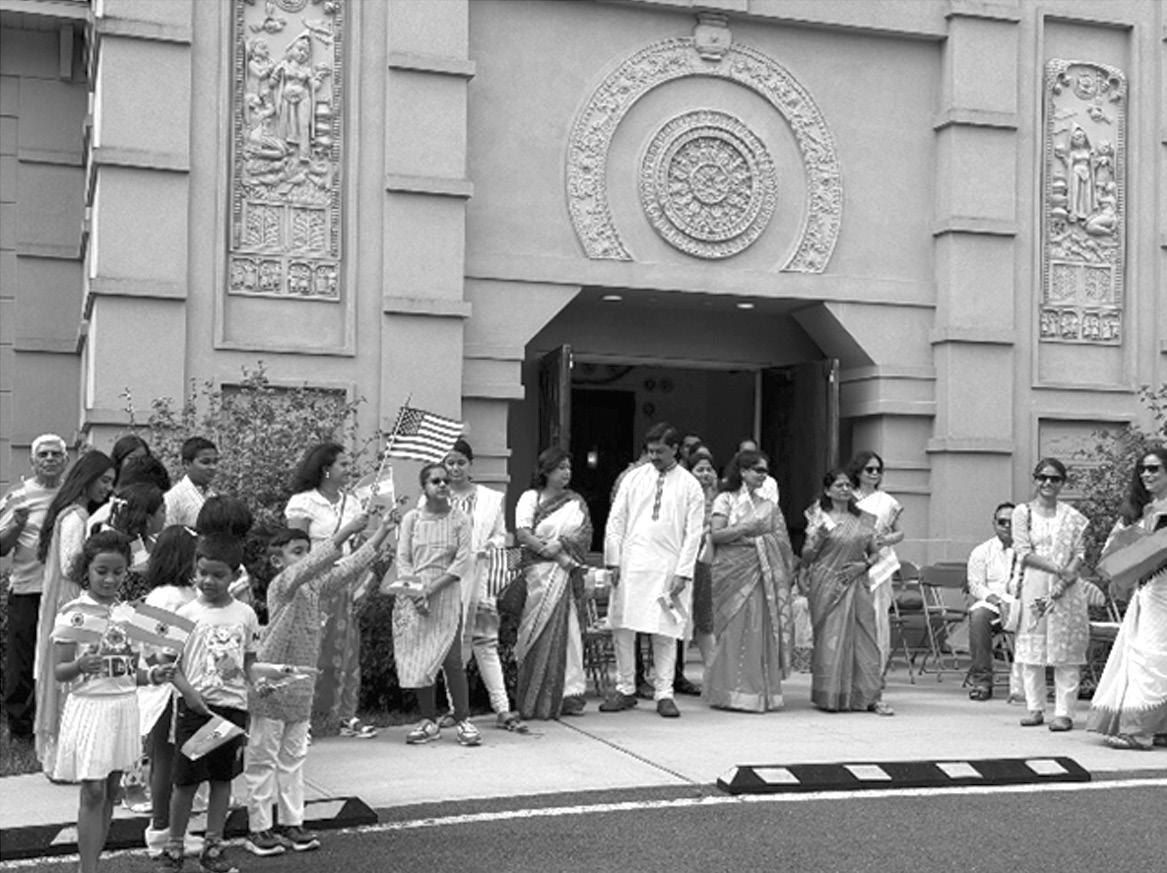
Mana.” The adult performances brought equal charm and energy to the stage: Saikat Mukherjee sang a Hindi patriotic song, “Sandeshe Aate Hai”. Suvra Dutta performed “Bharat Amar Bharat Borsho,” and Arun Bhowmick closed with a soul-stirring rendition of “DhonoDhanney.” The event concluded with warm applause, shared smiles, and a renewed sense of pride in our heritage and independence.
Through our Annual Food Drive on that day, wecollecteda generous amount of non-perishable food to donate to the Somerset Food Bank. Hope that we can continue this act of giving to the community in the future.
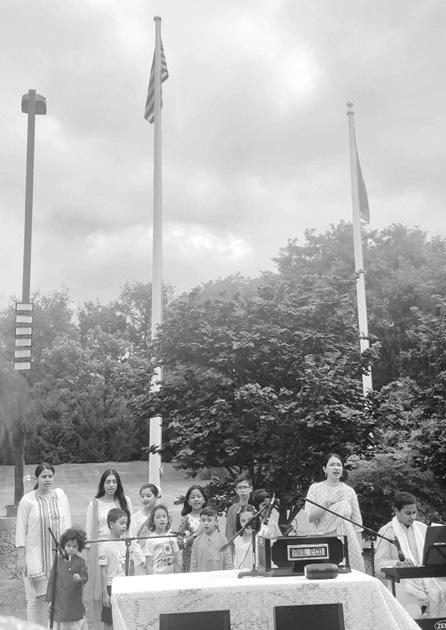
By Asok Baral (New Jersey)
When those few words were spoken, the cavernous hall of the Parliament of Religions reverberated with loud applause from the seven thousand-strong audience, and the applause continued for two minutes. The delegates were moved to see a young monk from a distant land in a saffron robe.He was not like other speakers but touched them with the natural and candid warmth of a brother. As he continued, he spoke not only of his own sect, but about all faiths that lead to God:
“As different streams, having their sources in different places, all mingle their water in the sea, so, O lord, the different paths which men take through various tendencies, various though they appear, crooked or straight, all lead to thee”.
To understand Swamiji’s coming to America, one has to go back to 1890, when young Narendranath at the age of twenty-seven left the Baranagar monastery and travelled all over India with a mission that he described to his friend and disciple, Sarat Chandra Gupta, “My Guru has asked me to dedicate my life to the regeneration of my motherland”. After traveling all over India, from the holy shrines in the Himalayas to central and southern India, he finally reached Kanyakumari, at the southern tip of India.
He saw a large rock in the sea and swam to it. As he sat on the rock and all of India was in front of him, he recalled what he had seen throughout India – extreme poverty, unscrupulous rulers, the tyranny of the caste system. He felt an urgent need to uplift the masses, but where were the resources? The rich people of India only talked and did nothing. According to Swami Nikhilananda: “the vision came, there flashed before his mind the new continent of America, a land of optimism, great wealth and unstinted generosity…. He would give the receptive Americans the ancient knowledge of India and bring
back to his motherland, in exchange, the knowledge of science and technology”.
Swamiji also remembered that towards the end of 1891 or 1892, he had heard about the Parliament of Religions in Chicago, and the earnest requests of his followers to represent India, particularly the words of his friends in Kathiawar : “Go and take it by storm and then return’’
Swamiji swam back to the Indian soil and walked all the way to Madras, where he first publicly announced his intention of visiting America. His fame had already spread across India, and his devotees collected some money for his voyage to America. But Swamiji refused to accept it and asked them to distribute it amongst the poor. He was wondering if he was getting carried away by emotions, or if the Almighty really wanted him to go. Then,in a dream, he saw Sri Ramakrishna walking on water and asking him to follow, and heard his authoritative voice, “Go”.
Swamiji wrote to Sarada Devi, the Holy Mother, who gave her blessings and said that it was Ramakrishna’s wish that he should go.
Then suddenly, the secretary of Khetri’s Maharaja Ajit Singh, who had been a disciple of Swamiji, showed up in Madras with the news of the birth of a royal son. Maharaja sought Swamiji’s blessings, and Swamiji came to Khetri in Rajputana. Maharaja persuaded Swamiji to accept the financial help so that he could attend the Parliament of Religions in Chicago. He also requested Swamiji to take the name Vivekananda, meaning “the bliss of discerning wisdom”. Swamiji agreed, and from then on Ramakrishna’s favorite disciple, Naren, became known as Vivekananda.
Maharaja accompanied him to Jaipur, and his secretary accompanied him all the way to Bombay. At Bombay, the secretary gave Swamiji a robe of orange silk, an ochre turban, some money, and a first-class ticket for S.S. Peninsular, which sailed from
Bombay on May 31, 1893.
The ship made many stops – Colombo, Singapore, Hong Kong, and reached Japan. Swamiji visited many cities in Japan and felt that the Japanese regarded India as “thedreamland of everything noble and great”. He finally reached Yokohama, where he boarded a ship named “RMS Empress of India”, bound for Vancouver.
On the ship, Swamiji accidentally met Jamshedji Tata, who was also going to Chicago for business. They discussed India at great length, and Swamiji inspired Tata to set up a research and educational institution in India. They also discussed plans for Jamshedji to start a steel factory. Those discussions bore fruit in 1907 when the Tata Iron and Steel Company was established.
Swamiji reached Vancouver on July 25, 1893, and boarded a train bound for Chicago. In the train, he met Miss Katherine Sanborn, who was a prolific writer of history, children’s fiction, literary criticism, and her own life experiences. She was also a popular lecturer and had gained a national reputation as a witty writer.
She was very impressed with Swamiji and wrote later in her book: “I could not take my eyes entirely from the cosmopolitan travelers …. I talked with all. and gave each my card, with “Metcalf, Mass.,” as permanent address. I alluded to the distinguished men and women in Boston and vicinity who were frequently my guests and assured all a hearty welcome at my farm. But most of all, was I impressed by the monk … He spoke better English than I did, was conversant with ancient and modern literature, would quote easily and naturally from Shakespeare or Longfellow, Tennyson, Darwin, Miiller, Tyndall; could repeat pages of our Bible, was familiar with and tolerant of all creeds. He was an education, an illumination, a revelation! I told him, as we separated, I would be most pleased to present him to some men and women of learning and general culture, if by any chance he should come to Boston.”
Swamiji reached Chicago on Sunday, July 30, 1893. There, he learned that no one
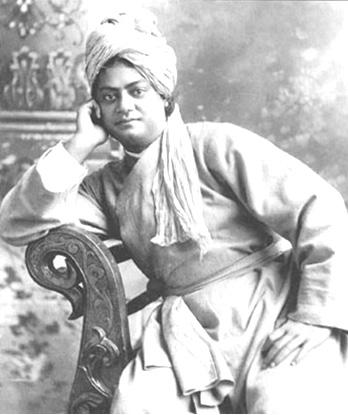
could attend the Parliament as a delegate without proper credentials. And it was too late to register even if he had proper credentials. Swamiji was utterly disappointed. He also learned that the Parliament would not open till the first week of September. None of his friends in India – the devotees of Madras, the Raja of Khetri, the Maharajas of Mysore and Ramnad – had made any inquiries about the details of the Parliament.
Swamiji stayed in Chicago for twelve days and visited the Exposition almost every day. He was thoroughly impressed with America’s technological advancement. However, his funds were depleting fast, and there had been a huge underestimation of the costs in America. He was told that the cost of living was cheaper in Boston, so he decided to travel to Boston and accept Miss Sanborn’s offer.
He became Miss Sanborn’s guest at “Breezy Meadows” in Metcalf, Mass. Here, Swamiji met many important people. But Mr. John Henry Wright, professor of Greek at Harvard, who was scheduled to meet Swamiji, somehow couldn’t. He had heard a great deal from Miss Sanborn, so he invited Swamiji to his city, Annisquam, where he rented a room for Swa-
miji at Miss Lane’s boarding house. Professor Wright invited Swamiji to spend the weekend with him in his summer cottage, called the Lodge, and it was during this weekend, Professor Wright was absolutely moved by the depth and breadth of Swamiji’s knowledge.
According to Mrs. Wright’s letter to her mother, Professor Wright and the townspeople talked with Swamiji all day and night, and again with interest the next morning. The townspeople were in wild excitement and were constantly in and out of the Lodge. Then the pastor of the Annisquam Universalist Church, Rev. G W Penniman, invited Swamiji to give a Sunday talk on August 25, 1893. This was Swamiji’s first public speech in America.
After seeing Swamiji’s wisdom, Professor Wright insisted that he should represent Hinduism at the Parliament of Religions. Vivekananda later wrote: “He urged upon me the necessity of going to the Parliament of Religions, which he thought would give an introduction to the nation”. When Swamiji said that he was not officially accredited and did not have proper credentials, Professor Wright said: “To ask for your credentials is like
continue to page 4 }
asking the sun to state its right to shine in the heavens”.
Professor Wright wrote to several people connected with the Parliament, including the chairman of the committee on selection of delegates, saying that, “Here is a man more learned than all our learned professors put together”.
Professor Wright bought Swamiji a ticket to Chicago. The train arrived late in the evening, and unfortunately, Swamiji had misplaced the address of the chairman of the committee. He did not know where to turn for help, and nobody bothered to talk to a foreigner. Looking around, Swamiji saw an empty wagon in the railroad yard and spent the night there with no food or bed.
In the morning, he woke up and walked to Lake Shore Drive. Again, his inquiry about the Parliament was met with total indifference by the passers-by. He knocked on a few doors in this fashionable neighborhood but was rudely turned away.
Totally exhausted, he sat on a sidewalk, and a lady from the opposite window saw him and sent for him. Swamiji told her about his situation. Mrs. George W. Hale was a high-society woman and knew all about the Parliament of Religions. She took care of Swamiji’s immediate needs and took him to Dr. J.H. Barrows, the President of the Parliament, who happened to be one of her personal friends. Swamiji was cordially accepted as a representative of Hinduism, and he became a guest of Mr. and Mrs. John Lyons. Swamiji was again convinced that the Almighty is guiding him to fulfill a divine mission.
On September 11, 1893, the Parliament of Religions was opened at the present site of the Art Institute of Chicago. (Please note that the date was exactly 108 years before the 9/11 terrorist attack which was borne out of hatred and intolerance of other religions). The meeting was an adjunct to the World Columbian Exposition, which was organized to celebrate the 400th anniversary of Columbus’s discovery of America. While the progress through technology was going to be the main theme, it was decided to include the Parliament of Religions, since religion was a major force in human culture.
In the Parliament, every religion was represented. The spacious hall and the huge gallery of the Art Palace were packed with seven thousand people. In the numerical order, Swamiji’s position was number thirty-one. The delegates rose and read their prepared speeches. But Swamiji was totally unprepared. He had never spoken to such a large assembly, and he was seized with stage fright. When his turn came, he requested to be postponed. He admitted later that after several postponements, when he rose to speak: “My heart was fluttering and my tongue nearly dried up”.
plause that followed, Swamiji continued: “I am proud to belong to a religion which has taught the world both tolerance and universal acceptance”.
Swamiji addressed the Parliament ten times in various sessions. The young, unknown monk became an overnight sensation in the religious world. His lifesize portraits were displayed in Chicago streets, and people bowed their heads in reverence. Newspapers all over the country published his speeches. The New York Herald said: “He is undoubtedly the greatest figure in the Parliament of Religion.”
Swamiji was invited by a speakers’ bureau to tour the United States, and he accepted the offer. He needed the money to pay back his friends and to support various philanthropic and religious projects in India that he had planned. Also, he knew that he could erase many wrong notions in American minds about the Hindu religion and society. Soon, Swamiji was on a whirlwind tour, earning the nickname the ‘cyclonic Hindu’. He visited Boston, New York, Washington, and more than a dozen other cities, including a few in Canada. At times, Swamiji gave fourteen lectures, and class talks in a week. He made his headquarters in Chicago with the George Hale family who had helped him so much.
In 1894, Swamiji founded the first Vedanta Society in New York. After his almost non-stop lectures, interviews, translations, writing and editing, including two trips to England and the continent, Swamiji left for India in December of 1896. After an enormous welcome from Sri Lanka to Calcutta, he established Belur Math and the Ramkrishna Mission. But his American students kept calling him. He was known to have diabetes, and doctors advised that going overseas would be good for his health.
So, in the summer of 1899, Swamiji returned to America, carrying his message all the way to California. He worked in both Los Angeles and San Francisco and established his second Vedanta Society in San Francisco in 1900. In the spring of 1900, he went back to India after a tour through Europe and Egypt. He spent the last two years in semi-retirement, consolidating his works in Belur Math and the Ramkrishna Mission. And in 1902, on America’s Independence Day, July 4, at the age of thirty-nine, Swamiji left this mortal world.
In America’s bicentennial year, in 1976, the Smithsonian Institution published a book titled “Abroad in America” to commemorate 27 visitors to this country, who did not stay here but influenced its culture. One was Swami Vivekananda.
References:
Swami Vivekananda and his 1893 Speech Vivekananda Biography by Swami Nikhilananda
By Anandita Chowdhury (New Jersey)
“Reached home”, I texted my husband. He was waiting anxiously, I could guess, for this text. Multiple recent news reports of flight mishaps clouded the minds of anyone with a loved one flying. Little did he know of the adventure that awaited me after I deplaned.
My in-laws would have shuddered in horror if I attempted to Uber my way home from the airport. So, they sent the tried-and-tested’parar dada’(neighborhood) driver to pick me up from the airport. Well, he missed the correct arrival gate, had to park in afaraway parking garage, and came looking for me after a long wait. Meanwhile, a local goon-type young man almost hijacked my luggage-filled trolley and then asked for “bideshi taka” (foreign money)before releasing the cart to me. The few miles’ drive from Kolkata airport to Belghoria seems more adventurous than my eight thousand miles flight from New Jersey to Kolkata via New Delhi!
Waiting for me at home, was rice and ‘halkamaacher jhol , by mom- in - law, which I ate, rather devoured, under my father-inlaw’s avid watch. Both of them, like all Bengali parents everywhere in the world, kept insisting I should have just a little more of every item on the menu. I went to bed full (bed already made, mosquito net and all, by the helpfulmaid, of course), and I woke up around the ungodly hour of 3:30 or so, famished. Trying hard not to wake the entire household up, I tiptoed to the kitchen, unearthed the containers of muri and chanachur, and settled down with an old Bengali novel from the bookshelf. Now the mosquitoes have a feast, too ! Me!
I fall asleep on the sofa, waking up a few hours later to the shrill whistles of the guy collecting the garbage. I try to catch a nap here and there throughout the day. But frequent ringing of the doorbell by the maid and the newspaper boy, and incessant shouts of the fruit, vegetable and fish vendors, interrupted my plan. As a result, I went around in a slightly zombielike state for the next few days. The new maid, I could see, a little disappointed, my disheveled, bedraggled state being nothing like the glamorous vision of ‘bouma from America’ she had expected to see and hoped to report to her friends.
place in Jadavpur, luckily without any adventure this time. “ Reached home”, I called and reassured my mother-in-law, because no matter what you manage to achieve in the US, once you reach Kolkata, you automatically revert to your young age where the elders were always slightly disbelieving of your ability to do anything by yourself and needed constant reassurance.
Meanwhile, the school friends’ WhatsApp group had been super-active the past fewweeks, planning a get-together in my honor. However busy they all were, whatever issues they might be facing in their personal lives, they had always managed to carve out a few hours one day during my visit to Kolkata, to catch up, chat, and bring back good old school day memories. Each and every time. This time, however, it seemed to be a little more difficult. The news of one of the members of our group being in a hospital, seriously ill, had all of us worried and upset. I managed to visit him for a few minutes in the short time allowed to visitors in the ICU, and chatted with his very worried wife in the waiting room downstairs on my way out. Imagine my surprise when I learned later from my other friends that this couple was actually divorced! This woman had flown in from another city and was staying in a hotel, having no home to stay in Kolkata anymore after the divorce, to take care of her ailing ex-husband! And, it’s her he had called for, reached out to, in his hour of need. Such care, compassion, sense of duty, not to forget the lingering interdependence, and yet, the marriage did not work. I didn’t know why this news, rather than that of the illness, made me sad and depressed.
In fact, this was one subject that came up many timesduring this visit. Social commentators would have multiple explanations for this, I am sure, but I saw only sadness and bewilderment in my parents’ eyes as they related such news. And I heard about many such breakups. Divorce and broken homes, once thought of as happening only to the elite and the rich, have managed to infiltrate my very conservative,middle-class extended family and my circle of friends in Kolkata.
After his address “Brothers and Sisters of America”, and the deafening ap-
Swami Vivekananda and America by Swami Yogeshananda
Swami Vivekananda – Beezone Library
Adding to my sense of frac-
continue to page 6 } | continue from page 3
A few days later, the same driver gets me to my mother’s
“In the spring of 1641, two Portuguese priests, Friar Sebastien Manrique and his associate, were taken to a gallery overlooking the principal reception room of a palace in Lahore. The palace belonged to Asaf Khan, one of the most powerful men in the Mughal Empire.
The hall was adorned with rich carpets of silken silver and golden embroidery. Perfume burned in holders arranged around the room. At its center was a fine muslin tablecloth with cushions around it.
As they watched, Asaf Khan’s guest, the fifth Mughal Emperor Shah Jahan, entered, adorned in strings of pearls and gold chains, accompanied by two other family members. Music played as beautiful girls washed their hands. Soon, servants carrying golden bowls of food entered the room, and two lovely damsels knelt on either side of the emperor and served him with food and drinks.
The meal lasted for 4 hours, and the priests were surprised to observe that these “barbarians had impeccable table manners.”” (Reference: “Curry – A Tale of Cooks and Conquerors”, by Lizzie Collingham)
Surely one of the dishes served to Shah Jahan was Lamb Biriyani, afavorite staple of the Mughals.
Shah Jahan’s great-grandfather, Emperor Humayun, had lost his kingdom to the Afghan ruler of Bengal, Sher Shah. He fled to Persia, and after 15 years in exile, returned to India. With the help of Persian money and arms, Humayun recaptured his throne. With him, he brought Persian culture – art, literature, music, and cuisine to India. (His father, Babur, the founder of the dynasty, was a prince from what is now Uzbekistan).
The pièce de résistance of Persian cuisine was the Pilau. It was made of fragrant rice, usually imported from Agra, which was cooked with almonds, raisins, saffron, and sometimes with fruits or chicken.
Humayun’s son Akbar was the first truly Indian Mughal emperor. He was born in India, and in his youth was a firebrand with wanton ways. He led the army in victorious battles and was fond of food, wine, and women.
As he grew older, Akbar became introspective and pursued a secular and ascetic life. He ate sparingly and drank only water from the Ganges River. A human chain of servants relayed that water from the river and ice from the Himalayas to his courts in Lahore and Delhi.
Akbar had Hindu wives and grew to love Hindu ways. He created a court culture that was a blend of Persian (Muslim) and Hindu beliefs and habits, in art, literature, religious philosophies, and cuisine.
Akbar’s Hindu cooks added fiery spices, meats, onions and garlic to the Persian Pilau, and the present-day Biriyani was born. From then on, Biriyani became a popular dish among the wealthy and established itself as a staple of the North Indian cuisine.
Fast forward to the year 1856. The Indian Sepoy mutiny was brewing. The East India Company, by this time ruling much of India, exiled the last Nawab of Awadh, Wajid Ali Shah, from Lucknow to Calcutta, the capital of British India, to strip him of all power and to keep an eye on him.
The Nawab brought his large retinue with him, amongst them his favorite chefs. He built his palace by the Hooghly River in Garden Reach, Calcutta, and settled down.
His chefs started making his favorite foods, including lamb dishes, like the Galouti Kabab and the Mutton Biriyani. (Reference: “Lucknow Cookbook”, by Chand Sur and Sunita Kohli)
The Biriyani soon became popular in Calcutta. Over time, chefs of less affluent families of Kolkata,
By Ranajit Mitra (New Jersey)
who could not afford a lot of meat, added potatoes and eggs to increase the volume and lower the cost of the dish.
The Kolkata Biriyani was born Today, it is one of the most popular dishes at many restaurants in the city, and has an almost cult-like following among Bengali food connoisseurs.
First, a few words about ingredients, cookware, and methods
I use US domestic lamb. I find the Australian variety to have a much gamier flavor. I like the shoulder chops, cut into fairly large pieces.
I use the best Basmati rice I can find, like Tilda Grand or Zafrani Reserve. The Persian noblemen made quite a fetish of it, importing the best aromatic rice from India and soaking it in salted water to attain a pearly white texture.
Saffron gives Biriyani its unique color and flavor. The best saffron comes from Iran (no wonder!). It is expensive, but you need very little for each batch of rice.
The Mughal Biriyani was made in a heavy pot with the lid sealed by dough. Hot coals were placed on the top and the bottom of the pot. This is called theDum Biriyani method.
I have found that a good approximation of the above method is to assemble the biriyani in a “Dutch oven” like Le Creuset, and do the final cooking in a moderate-temperature oven. You’ll need a 6- or 8-quart pot with a heavy lid toseal the contents completely.
Ingredients (Serves 6 people)
1. A pinch of saffron
2. A cup of lukewarm whole milk
3. Three cups of Basmati rice washed a few times and dried
4. Two tablespoons of ghee
5. 4 cups of good quality chicken broth (Swanson or Wegman’s)
6. One small onion, 2 one-inch cubes of peeled ginger, and 4 large cloves of peeled garlic, all pureed in a blender with a bit of water
7. ¾ cups of whole milk yogurt
8. Three lbs. of lamb shoulder chops (bone in), trimmed of fat, and cut into large pieces
9. Two tablespoons of Ghee
10. One tablespoon Mustard oil
11. Whole Garam masala – 6 cloves, 2 sticks cinnamon, 2 bay leaves, 4 small cardamoms, 2 large cardamoms
12. 2 dried red chilies
13. Six green chilies, finely diced
14. One large onion, finely diced
15. Two teaspoons each of Cumin, Coriander, and Kashmiri red chili powders
16. One teaspoon of sugar
17. Two tablespoons of ketchup
18. Salt to taste
19. Three cups of chicken broth
20. Four hard boiled large eggs, peeled
21. Two large Yukon Gold potatoes, quartered
22. Quarter cup of melted Ghee, one tbsp garam masala powder, a handful of cilantro leaves diced, and six green chilies, for finishing
1. Grind the saffron in a mortar and pestle, and stir into the cup of hot milk. Let the mix soak for an hour. The liquid will become dark yellow in color. Strain into another cup.
2. Melt the two tbsp ghee in a medium saucepot, pour in the washed and dried rice, and sauté for a few minutes. Pour in the 4 cups of chicken broth, bring to a full boil, cover, and remove fromthe heat. Let it sit for an hour covered.
3. Marinate the lamb in the onion-ginger-garlic puree and the yogurt. Let it sit for an hour in the fridge.
4. After an hour has passed, set the oven to 325°F and preheat.
5. In a Dutch oven, heat the two tbsp ghee and one tbsp of mustard oil.
6. When hot, add the whole garam masala pieces and dried red chilies, and let them sizzle. Add the diced onions, diced green chilies and a pinch of sugar. Sauté till onions are golden brown, and remove half of it to a plate and set aside.
7. Add the marinated lamb and all the marinade to the pot, then add the spice powders, sugar and ketchup. Sauté on moderately low heat for about 20 minutes. If the spices start to stick, add splashes of water,
8. Add the chicken broth, salt, and potatoes; bring to a boil, and simmer covered for about thirty minutes until meat and potatoes are mostly cooked. Uncover and boil off some of the liquid until a semi-thick gravy is left.
9. Take the Dutch oven off the heat, and place the boiled eggs around the top.
10. Fluff the cooked rice with a fork and pour it over the lamb. Drizzle the saffron all over the rice, and do the same with the quarter cup of melted ghee. Sprinkle garam masala and cilantro leaves, cover tightly, and place in the preheated oven
11. Bake for one hour
12. Remove from oven, uncover, and with a large ladle, gently mix all of the contents without breaking the rice grains.
13. Serve hot in individual bowls, top with caramelized onions and green chilies, and with sides of cucumber Raita.
Effective August 15, Ananda Mandir’s Publication Committee has been reorganized as shown below:
Chair : Debajyoti Chatterji
Assistant Chair : Subrata Bhaumik
Editor-in-Chief, Anandalipi : Subhodev Das
Editor-in-Chief, Ananda Sangbad : Asok Baral (Effective January 1, 2026)
Editors : Pradip Das, Tathagata Ghosh, Sophia Mitra, Rahul Ray
Collectively, the team will continue to be known as the Editorial Board.
We welcome three new members to the team: Asok Baral, Pradip Das and Tathagata Ghosh
They are all well-known within our literary circles. As we welcome our new members, we say goodbye to Ruby Banerjea, Amrita Kangle and Nupur Gangopadhyay Lahiri for their past contributions.
We are delighted that Asok Baral has agreed to take over the responsibilities of Editor-in-Chief for Ananda Sangbad, effective January 1, 2026.
By Sajal Mukherjee (New Jersey)
I was born in 1962 in Bhilai, a steel township carved out of the red earth of what was then Madhya Pradesh (now Chhattisgarh). The Bhilai Steel Plant was the reason we all existed there - a grand industrial dream that drew people from every corner of India. The township had schools, shopping centers, clubs, and parks, but it also sat beside villages whose Chhattisgarhi-speaking natives had been pushed to the margins, taking up work as gardeners, rickshaw pullers, and domestic help.
It was a place of mingling - the smells of idlis, parathas, and fish curry all wafting through the same neighborhoodbut it was also a place of contrasts. Over time, those contrasts and a few small incidents quietly shaped the person I became.
The Gardener and the Piggy Bank
Around 1972–73, a severe drought swept across Madhya Pradesh. Even in our neatly laid-out township, the signs were everywhere - wilted gardens, dry taps, and more strangers knocking on gates asking, “Pasiyan de de bai” - rice starch water - to keep hunger at bay.
One afternoon, I saw a familiar figure at our gate. He was a local gardener who came a few times a year to tend our plants. But this time, he wasn’t carrying tools. He looked frail, his voice barely above a whisper as he asked my mother for something to eat. She gave him food, and he began to walk away.
Something inside me wouldn’t let it go. I ran inside, opened my piggy bank, and pulled out my entire savings - a princely sum of twenty rupees. For a tenyear-old in those days, that was serious wealth. I chased after him, pressed the notes into his hand, and ran back before he could say anything.
Even now, over fifty years later, I remember that moment. It taught me that if you have more than enough, you must share it. My belief in charity didn’t start in some management seminar.It started with a hungry man, a drought, and a boy’s piggy bank.
Bhilai wasn’t just diverse - it was divided. Officers lived in larger quarters with gardens and better facilities. Workers lived in smaller houses. The difference showed up in the schools, too. Officers’ kids usually went to English-medium schools (with a small fee), while most workers’ kids went to free Hindi-medium schools.
My father wasn’t an officer when I was small, but he still sent me to an Englishmedium school. Many of my classmates came from officer families. I remembervisiting their bigger homes, hearing
stories about their summer holidays at the Officers’ Club - complete with swimming pool and the added “educational benefit” of watching “beautiful girls” swim. My version of this luxury was sitting at home with a glass of ‘Ruh Afza’ or Rasna, listening to their tales the next day.
No one made me feel lesser, but my mother would occasionally refer to those neighborhoods where the Officers’ Quarters were located as “the richer people’s neighborhood.” That phrase lodged in my mind. Maybe that’s why, when I had my own family, I made sure my children had the things I quietly wished for back then.
I must have been in second or third grade when my class teacher picked me for our annual day play. I have no idea why. Maybe she saw something in me, or maybe I just fit the costume - a white dhoti and kurta.
I don’t remember the script, but I do remember rolling my eyes dramatically and delivering a few lines, which at the time felt like award-winning theatre. For a shy, introverted boy who was more often bullied outside home and reprimanded at home than celebrated, that applause was electric.
A few months later, at a wedding in Kolkata, I performed a “mono-act” about a thirsty man finding water. People clapped and said “Well done!” That was all it took. I wasn’t good at sports, and I was quite decent in academics but only through sheer hard work, but this - this was something I could be good at. That was the day I began my lifelong love affair with theatre, a passion that continues to this day.
Our family of five lived in a modest tworoom-and-kitchen house. It never felt small, but I could see that they struggled hard to make ends meet. One of my sweetest childhood rewards was an annual ice cream - yes, annual - tied to my performance in my final exams. I would savour every bite like it was the last ice cream on Earth.
Movies were the same - maybe once or twice a year. The cool air of the cinema, the magic of the big screen… scarcity made every moment sparkle. Today, ice cream and movies are everyday things. But they no longer taste quite the same.
By the time I was in 11th or 12th standard, theatre had me hooked. I even thought of taking it up as a profession. But then
| continue from page 4
tured stability and lack of continuity was the news of vanishing homes. The residences of relatives I had visited throughout my early years, and even afterwards during my trips back home, were no longer there. The ever-increasing number of ‘flatbaris’ s, and the all-encompassing grasp of the ‘ promoters ‘, have taken over the ‘kakarbari ‘ or ‘mashirbari’ of my youth. The ‘rok’ I used to sit on and shell peanuts with one cousin, the veranda I used to lean over and look down the street below with another cousin, had vanished. “ No one of your generation is back here with us, we can’t keep up with the maintenance of the big house by ourselves, this small flat is good for us now”, my uncles and aunts told me with sad smiles. The talk invariably turned towards those no longer with us. They regaled me with stories of “Remember when you were six and you had...”. Stories I had heard before, but stories both the narrator and the listener enjoyed re-visiting. Their eyes look out the window into the fastchanging neighborhood, trying to make sense and keep up withthe new surroundings.The practical part we all understand, but the heart still yearns for what is lost forever.
Was it all about loss and change on this trip back home, then? Did I manage to gain nothing?
Of course I did!
Our friend improved slightly, and our moods were lifted, so we proceeded with our get-together. My friends came from all over the city. For a few hours, we shed the decades off our minds and go down memory lane, reliving the mischievous carefree school days when the greatest worry in life was whether we’d manage to get “ common” questions on the exams. Technology lends its hand.A friend joined in by video call from the UK. The day brings another round of “Remember when back in class 8...”. Some of these shenanigans were unknown events to our parents, but fondly remembered and revisited with bursts of laughter by us. This meeting, as always, was like an infusion of fresh oxygen of hope and laughter in our middle age.
Speaking of middle age, I was always apprehensive of the day street vendors of Kolkata would start addressing me as ‘ mashima’ instead of ‘ Didi ‘. Well, it seemed that day was no longer in the future (not because I have stopped aging), but because the Kolkata shopkeepers and vendors had moved from didi, boudi, mashima to the ubiquitous ‘mam ‘. I heard this again and again, as I jostled with the crowd on the foot-
paths of Gariahat and meandered past the shops at Dakhinapon. I revisited these familiar jaunts of our college days every time I visited the city. Back from the shopping trips, I get interrogated by my mom, “kotocheyechilo” and”kotodiyecho”. And I admitted sheepishly that I had not yet mastered the art of bargaining. As I dumped these gaudy, junk jewelry and flimsy purses into my suitcase, I wonder how many of these would be used at all back in the US. How on earth I would shut that suitcase was another glaring question. Yet, somehow, I could not seem to resist the oldworld charm of these streetside shops!
And the street food! Oh my, Kolkata street-food! My mom and mom-in-law insist on bottled water for me, “Your system has been Americanized by now” being their logic. Little do they know of my ongoing love affair with roadside fuchka, egg roll, vegetable chop on these frequent shopping trips. No number of years offshore could change or would be able to change my taste buds, ever. You can take the girl out of Kolkata, but you can’t take love for Kolkatafuchka out of her!
The days passed quickly. Two weeks gone in the blink of an eye. Bags packed, carat the door. I touched the feet of my elders, their trembling hands on my head blessed me. Like every immigrant making this trip back, I hoped and prayed that these hands would be there to bless me again on my next trip back. They all crowded in front of the door, even following the car out on the street for a bit. I looked back as far as I could, till the car turned a bend and they faded out of sight. I imagined them slowly walking back in, climbing the stairs to empty rooms, sitting and staring blankly at the TV, thinking and rethinking about the past few days. I looked out the window at the bustling streets outside. Why was my vision blurry all of a sudden? Something from the streets must have flown into my eyes!
I made the reverse trip back. From Netaji Subhash Chandra Bose to Indira Gandhi, from Indira Gandhi to John F Kennedy. airports, cities, cultures, habits. Lives.
“ Reached home “, I called and let my mother and mother-in-law know.
Like the poet of our hearts said, “deshedeshe mor ghorachhe”. I have my home, I have my country, everywhere.
Home is where the heart is, and my heart is stretched over two continents. I spend my life trying to find a symmetry between the two.
Reported by Mita Sinha, Chair, Puja Committee
During summer, daylight hours are the longest and darkness hours are the shortest. So, these few months offer a good time for activities like family vacations. However, we, at Ananda Mandir, were busy this summer. Devotees of Ananda Mandir visited the Temple frequently during the summer.
Held on July 1, Bipadtarini Puja was our first puja of the month. The brata was observed on a Tuesday in the month of Ashar in West Bengal. On this day, Ma Kali is worshipped with the offerings of 13 different kinds of fruits and flowers. She was also offered 13 paan, supari, red thread, and sweets. At Ananda Mandir, this puja was performed in the morning. A good number of devotees visited the temple on this day. After the puja, we all had prasad.
On July 5, we celebrated Ulto Ratha Jatra at our temple. This marks the return journey of Lord Jagannath, Balaram and Subhadra to the temple. This celebration happens nine days after the main Ratha Jatra festival. The deities areplaced on the Grand Chariot with flowers and garlands. Devotees pull the chariots within the temple grounds, and after a couple of rounds, the deities are brought inside the temple. We also had Satyanarayan Puja on this day. The day ended with a grand dinner.
The last puja for July was our monthly Shyama Puja, celebrated on July 24. A large number of devotees visited the temple on this day, and our priest, Biswabhai, conducted a beautiful puja, as always.
The month of August started with Rakhi Purnima and Satyanarayan Puja on August 9. Rakhi Purnima/Raksha Bandhan is a popular ceremony celebrated by Hindus everywhere. On this day, sisters of all ages tie a rakhi around the wrists of their brothers and receive a gift in return. At our Temple, we did this ritual after the Satyanarayan Puja
The next puja for this month was Janmashtomi, celebrated on August 16. This is an annual Hindu festival celebrating the birth of Lord Krishna. Krishna’s birth is a moment of hope and kindness. It is an important festival, particularly to the Vaishnavs. We celebrate this day to honor Krisnha’s wisdom, compassion, and strength. Janmashtomi is observed on the eighth day, Ashtami of the Krishna Paksha. It is one of the most sacred festivals, celebrated with prayers, bhajans, fasting, and midnight rituals marking the exact birth time of Lord Krishna.
Koushiki Amavasya puja was our next puja in August. This is celebrated in the month of Bhadra. This day has a special significance in Buddhist and Hindu Tantra. With the incar-
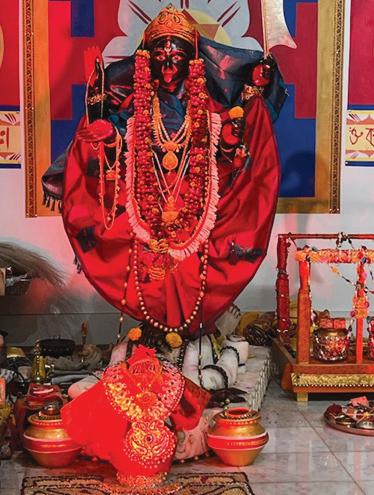
nation of the Goddess Koushiki, the earth was freed of the darkness of ignorance and was illuminatedby the divine light of knowledge.
We also had Satyanarayan Puja in the evening on this day. Many devotees visited the temple for the puja, and after the puja, enjoyed delicious food.
Ganesh Chaturthi was the last puja of this month. This puja is celebrated all over India. Each state has its regional aspect associated with its rituals. At Ananda Mandir, we observed this puja in the morning.
The first Puja in September was our monthly Satyanarayan Puja. Lots of devotees attended this puja. We had the puja, havan, reading the brata katha and observing the aratiat the Mandir.
Biswakarma Puja was scheduled on September 17, also in the morning. According to Hindu beliefs, Lord Biswakarma is the celestial architect, engineer and craftsman of the universe. This sacred day holds great significance for artisans, mechanics, engineers, architects and people working in industries and workshops. We perform this puja in the morning at Ananda Mandir.
The last puja for this month was Mahalaya/Til Tarpan on September 21, starting at 9 in the morning and lasting until noon. On this day, sesame seeds, mixed in water,is offered to the deceased ancestors’ souls, to show our respect to them. We had many visitors at our premises on this day to perform this ritual.
In the evening, we had our monthly Shyama Puja. This is a special puja at our temple, and after the puja, we had our dinner. It was a busy but enjoyable day for all of us.
Anada Mandir is a popular temple in New Jersey, especially for the Ben-
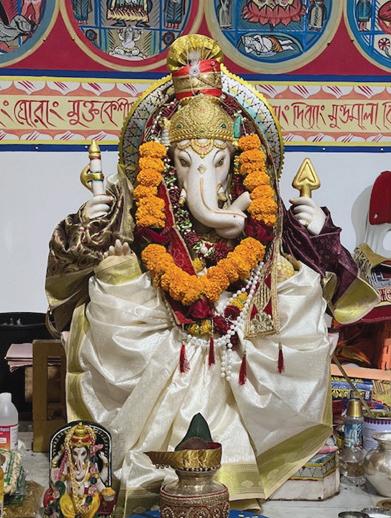
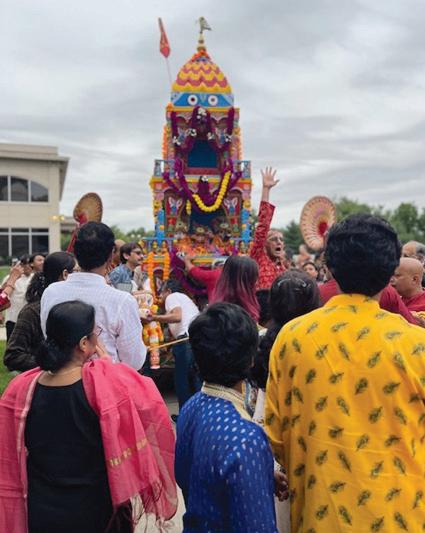
gali community. People come from far to perform weddings, poite (sacred thread ceremony), annaprasan, shraddha, and batsarik, to name a few. Our temple is spacious and can accommodatea lot of people for various events. We also have a community hall that members can rent for different occasions. We have a huge parking lot, and overall, it is an attractive
place. We invite everyone to come and enjoy this special temple.
Durga Puja is around the corner, and we celebrate this puja with great fanfare. Please come and register for all five days of puja, and enjoy all the festivities with your friends and family. To register, go to www.anandamandir.org. All details are available on our website.
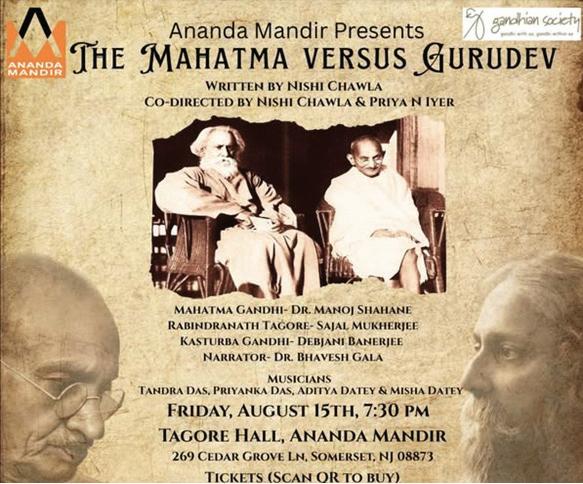
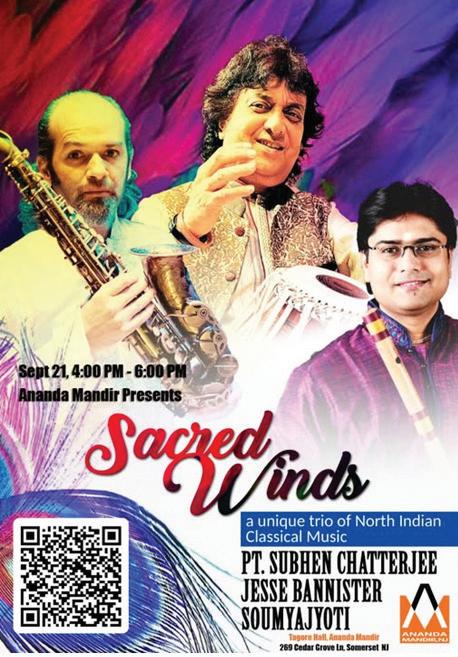
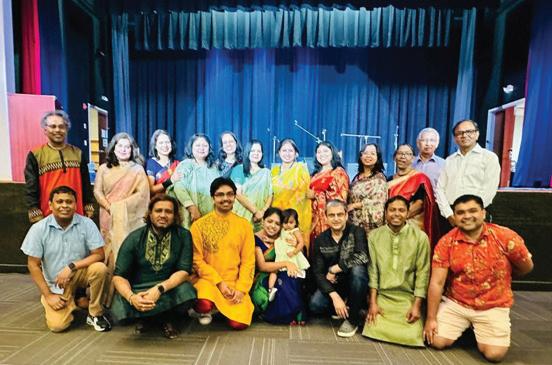
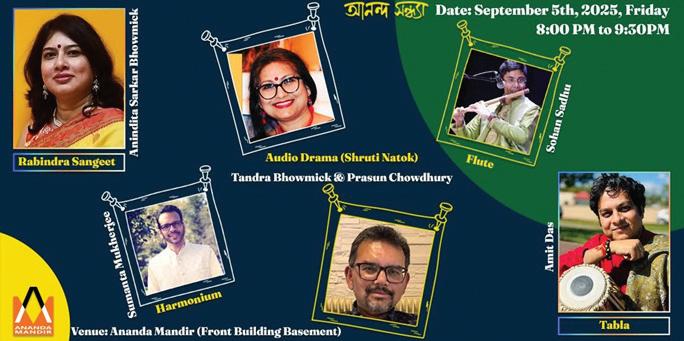
1. “The Mahatma and Gurudev”, presented on August 15
2. Musical program presented on September 21
3. Members of Rhythm Spec, a local group, performed on the occasion of Annual Fundraising Lunch on July 27
4. “Ananda Sandhya”, held on September 5
“What feminism means for me is simply that women, like men, are complete human beings with limitless possibilities.” -Fahmida Riaz, Urdu poet from Pakistan I was sitting shocked with the news from Kolkata that the wonderful lady I had greatly admired for many,many years had passed away. And what an eerie coincidence! A message came in my Google mailbox with the above quote, very aptly describing the feisty qualities of my esteemed heroine: “A complete human being with limitless possibilities.”
As usual, I had started the day with the Wall Street Journal. Then I opened my computer for the papers from the subcontinent. And the news I was dreading for some time occupied the headline on the first pages of Ananda Bazar Patrika and Prothom Alo – the leading vernacular newspapers in the habitat of Bengali people on either side of the border. I was dreading because Mahasweta Devi had been admitted to Belle Vue Hospital in Kolkata on May 22 with infections in the lungs and was showing no sign of improvement, even under the constant care of a board of leading medical experts of the city. Also, both herkidneys were not functioning due to uncontrolled diabetes for a long time. Near the end, they could not even carry out dialysis. She was kept with oxygen input for 24 hours. The end came at 3:16 PM on Thursday, July 28.
Here is a brief introduction to Mahasweta Devi’s life.
Mahasweta was born on January 14, 1926, in the present-day Bangladesh. Her father, Manish Ghatak, was an eminent writer of the Kallol era. He wrote lots of poems and novels under the pseudonym “Jubanaswa’. Her mother, Girija Devi, was also an accomplished writer and a social worker. While her paternal uncle,RitwikGhatak, was an internationally acclaimed filmmaker, her maternal uncles were noted sculptor, Shankha Chowdhury, and renowned economist, Shachin Chowdhry.
Mahasweta began her schooling in Dhaka but shifted to Shantiniketan, the school started by the poet, Rabindranath Tagore. Mahasweta did her B.A (Hons.) in English from Viswa Bharati and M.A in English from Calcutta University. As a student, Mahasweta was greatly influenced by the communist ideology that was prevalent at the time. She married renowned playwright-author-poet, Bijon Bhattacharya, who was one of the founding fathers of the Indian People’s Theater Association (IPTA) movement.
In 1948, Mahasweta gave birth to Nabarun Bhattacharya, who grew up to be one of Bengal’s and India’s leading novelists. His works have been noted for their intellectual vigor and philosophical flavor. Mahasweta divorced Bijon Bhattacharya in 1959. Both Bijon and Nabarun had preceded Mahasweta.
My adulation for Mahasweta began in the autumn of 1983.
In October 1983, a few days after Durga Puja, I was on British Airways Flight 098, the once weekly overnight flight
By Manoj Kanti Debroy (New Jersey)
from Dhaka to Doha. I was returning from my annual holiday in Dhaka to my place of work in Qatar, then virtually a desert. My companions were a collection of Pujabarshikis – Desh, Ananda Bazar, Naba Kallol, etc. To passthe time during the five-hour flight, I opened one of them. If my memory serves me right, it was Desh. There was only one barogalpa- a long story or a novella - in the issue. I settled on this one, suitably supported by a couple of beers and nuts that the air hostesshad provided.
But the story jolted me out of my stupor. What a beautiful rendition of a wonderful topic! The story told us about the life of the beggars who ply their trades in front of the Jagannath Temple in Puri. While most of them were locals, one was a very weak, half-crippled man who came from a place far away from Puri. He was sneered at as an outsider (Bahiri) and tormented by the local gang.
Just for reference, I grew up in postpartition East Bengal (then East Pakistan), hardened by continuous suffering and a multitude of super-discriminations by both the state and the society in my everyday life. I had weathered manycommunal riots.I was constantly sneered at by taunting people around me - “Eita to togo Desh Na”.
“It is not your home country”.
Seeing my agitated expression, the airhostess enquired whether everything was OK. I told her, “No, nothing will be the same again”. I asked her to give me a couple more beers and told her to take the magazine and read the story during her break, and return the magazine to me when we disembark. For reasons unknown,she took the magazine and gave me what I had wanted. After the beers, I fell into a state of half-asleep. The kind air hostesswoke me up a few minutes before disembarkation and returned the magazine. My lifelong admiration for writings of Mahasweta continued to grow from that day.
Most of you are familiar with her work as a prolific writer par excellence: Hazar Churashir Ma, Aranyer Adhikar, Rudali, Kulaputra, Agnigarva, and so many more.Many of these were made into meaningful films by master fi, filmmakers. She was honored with many recognitions, such as the Sahitya Academy Award, GyanapithAward, SAARC Literary Award, Yashwantrao Chavan National Award, Banga Bibhushan Award. She was shortlisted for the Man Booker International Prize, and the Government of India honored her with Padma Bibhushan in 2011.She was also honored with the Asian Nobel, the Magsaysay Award,in 1997 for her social upliftment work.
But what impressed me most was her untiring work for the poorest of the poor in Indian society. Because of her, we came to know about the trials and
tribulations in the life of Kheria Shabars and the Lodha communities. Throughout southern West Bengal, Bihar, Jharkhand, Madhya Pradesh and Odisha, she worked for the welfare of the banabashi(forest dwellers) tribals who were constantly being exploited out of their habitat by the state.
A few months before my introduction to Mahasweta’s writing, I had been introduced to Nadine Gordimer, the writer and social worker of South Africa, who got the Nobel Prize in literature. My eternal regret is that while the world recognized Ms. Gordimer’s creativity and struggles, the wonderful persona and writings of Mahasweta were not celebratedin the Western world.
To describe her work in her own words: “I have always believed that the real history is made by ordinary people. I constantly come across the reappearance, in various forms, of folklore, ballads, myths and legends, carried by ordinary people across generations. ... The reason and inspiration for my writing are those people who are exploited and used, and yet do not accept defeat. For me, the endless source of ingredients for writing is in these amazingly noble, suffering human beings. Why should I look for my raw material elsewhere, once I have started knowing them? Sometimes it seems to me that my writing is really their doing.”
I take the liberty to quote from an obituary published in the Hindu, a major Indian newspaper:
“I don’t want to die,” she said, “I want to live forever.” There was so much to do, so much to write about. If she did die, however, she wanted to be buried and a mahua tree planted on her grave.
On July 28, Mahasweta Devi, at the age of 90, unbound the ties of mortal life and set off to live forever. Her deeply political novels, short stories and columns have nurtured generations of readers of Bengali literature. As one of the most widely translated authors from contemporary India, she had readers all aroundthe world. She was already in forever-land.
I end my humble tribute to this wonderful heroine of mine, quoting two messages of condolences from two towering personalitiesfrom opposite spectrums of Indian politics:
Srimati Mamata Bannerjee(Chief Minister of West Bengal):
”India has lost a great writer. Bengal has lost a glorious mother. I have lost a personal guide. Mahashweta Di, rest in peace.”
Sri Narendra Modi (Prime Minister of India) :
Mahashweta Devi wonderfully illustrated the might of the pen.
A voice of compassion, equality and justice, She leaves us deeply saddened. Rest In Peace.
| continue from page 6
my father, in his quiet, practical way, sat medown. “You can do whatever you want,” he said, “but remember, we are ordinary people. I can’t leave you any wealth. You’ll have to take care of yourself. In theatre… not everyone survives.”
I would like to believe that it wasn’t meant to discourage me, just to prepare me. But it worked. I dropped the idea and chose engineering instead. I was decent at maths, so it seemed sensible. The next four years were miserable. I realized I wasn’t meant for engineering at all. Eventually,I moved into software, discovered that I was good at analyzing situations and managing people, and rose quickly. But part of me always wondered what might have been if I’d followed my first love. On the other hand, I’ve often felt I didn’t make the most of the opportunity I had in Engineering School, especially since several Bhilai classmates went on to earn advanced engineering degrees. Maybe that’s why, all these years later, I’m doing a doctorate in business management - to close the loop on that unfinished chapter.
When I think of Bhilai now, it isn’t just the clang of steel or the smell of red dust that comes back. It’s the image of a gardener walking away with twenty rupees in his hand. It’s the sound of applause from a school stage. It’s the taste of a once-a-year ice cream.
We grew up in a time when scarcity made things precious, when class differences were quietly understood but rarely spoken of, and when life decisions were often shaped as much by economic reality as by personal passion.
And maybe that’s why, even after all these years in the US, a part of me is still that boy in Bhilai - running after someone who needs help, standing in costume on a stage, or savoring an ice cream like it’s the rarest treasure in the world
Ananda Sangbad
Adda represents a longheld tradition of Bengali life. It is an informal gathering where friends, family, even strangers, engage in fluid and relaxed conversations. There are no established rules, and the topics range from literature to politics, from science to sports. For Bengalis, known for their gregariousness and love of conversation, adda is an essential part of the day. (Prosenjit Lahiri. Conversations
That Heal: The Power of Adda in Bengal, One World Outlook, May 2025).
Tania Banerjee wrote in “Adda: The secret to Bengali Conviviality, BBC 2021”: In the vibrant and diverse cultural landscape of Bengal, the practice of adda stands out both as a tradition and a contemporary necessity. Adda, far from being a mere chitchat, provides the ritual thread that weaves through the fabric of the community. One thing that the Bengalis would agree on is that the word adda has a definite sense of endearment and warmth that cannot be found in any other word. While adda can be loosely translated as a ‘hangout’, it cannot capture all the nuances and oversimplifies the action. Colloquial terms like “ganjano” and “gultani” are often used instead of “adda”, but these words carry a negative connotation that highlights their connections with idleness.
(Dipesh Chakravarty Adda, Calcutta: Dwelling in Modernity, Public Culture, 1999} The practice of adda as embedded in Bengali psyche is more than just a pastime, it is a key to the happiness for many Bengalis. Traditionally, a perfect adda should include a little bit of everything – politics, art, literature, science debate, gossip, joke, rumors, food, cigarette and tea. It can take place anywhere - in a private home, a local tea shop, a park, or a verandah.
Ananya Chatterjee in “This Bengali Ritual Is a Cure for Loneliness,Ova, July 15. 2024”, stated that the word adda exists in other Indian languages, but for Bengalis, it is an integral and quintessential part of what it means to be a Bengali. Chatterjee further noted that the famous Bengali writer Buddhadev Bose claimed in his seminal essay ‘Adda” that it may be pan-Indian, but “it reveals itself in the fullest glory in the moist breeze of Bengal. Our seasons quicken adda the same way that they awaken poetry”. In a way, adda created an identity for the middle-
By Mandira Chattopadhyay (Massachusetts)
class families, especially in response to the cultural hegemony of the British imperialism. Its origin can be traced back to the colonial times when Calcutta was a cluster of humble settlements on the banks of the Hooghly River.
The British colonialists influenced the food habits, language, literature, philosophy, even the art of conversation.
Then a new class of affluent Bengalis emerged who worked as clerks, administrators and merchants under the East India Company. These educated and wealthy Bengalis gathered daily in their private premises to participate in casual but long discussions on endless topics. And the practice of adda soon spread beyond the upper class.
In 1817, the first institution with a focus on the western education, Hindu College, was established. A part of it later became Presidency College (now Presidency University). Calcutta University was founded in 1857. In the road adjacent to these two institutions, now known as College Street, several bookstores started popping up. In 1942, a coffee shop was opened where the students hung out during recess. In 1947, its name was changed to Indian Coffee House, and it remains a hub of adda even today. The Coffee House has been a significant part of Kolkata’s culture, and it has been immortalized by the eminent singer, Manna Dey, in his song: “Coffee Houser shei adda ta aajaarnei,” translated as “that adda of Coffee House is not anymore”.
A visit to the College Street Coffee House is a must to relive the adda experience of Kolkata. It has been the goto place for numerous groups of friends across generations. They spent their youth hanging out at this iconic eatery. It was the hub of famous writers, nationalist leaders, politicians, film makers and many other luminaries. Indian Coffee House was frequented by intellectual stalwarts like Satyajit Ray and Sunil Gangopadhyay.
Coffee House was the center of the activities of the Naxalite movement started by the students in late 1960’s and early 1970’s. And it remains a forever favorite place for college students. The ‘Hungry Generation’ of poets
of the 1960’s who rejected the style of the previous Bengali poetry had their fiery gatherings in the Coffee houses of Kolkata. Sunil Gangopadhyay, a leading voice of the movement, once remarked that their poetry was as much as the result of arguments over endless cups of tea as it was of solitary inspiration.
Going back, we see the roots of adda in Bengali villages, where elders used to assemble and discuss local politics. Over time, the practices changed, and literary sessions came into being. These became more fashionable by the illustrious Tagore family of Jorasanko. In later years, the ‘Monday Club’ came into being, and it included luminaries like Sukumar Roy, Dr. B.C Roy, and P.C Mahalanobis. Even the birth of the ‘Bengal Renaissance’ is said to have generated from the addas which were held in the house of the famous teacher and poet Henry Louise Vivian Derozio in early 19th century. Moreover, the addas held in the office premises of the reputed periodicals like Probashi, Porichay, ShanibarerChithi, Kallol, and Desh were known for their contributions to the evolution of the Bengali culture and tradition (Swati Chattopadhyay, Representing Calcutta: Modernity, Nationalism, and Colonial Uncanny, Routledge. 2006).
The famous literary figure, Syed Mujtaba Ali, in his essay on Adda (part of his book Panchatantra, Bengali Edition, Biswabani 2020) described certain features of addas in Bengal and in Cairo, Egypt. He noted that adda was not only a pastime in Bengal, but also the hub of Bengalis’ intellect, innovative spirit, and social interactions. It was the place where everyone participated equally and there were no boundaries or formalities. Bengali adda, he stated, took place in tea stalls, College Street, temple halls, mansions of the wealthy, and outside of offices, and the topics could include politics, literature, romance, philosophy, history and so forth. There was an element of spontaneity as well as liveliness in Bengali adda He said that many Bengalis thought that the adda culture was prevalent only in Bengal, but it was much more widespread.He went on tomen-
tion his experiences in Cairo, where he spent a good part of his life.
In Bengal, Mujtaba Ali stated, the adda in someone’s house might have been restricted because the attendees could feel loyal to the owner, or the owner’s wife could be a distraction.So the attendees were not free to express their opinions. But in Cairo, the adda never took place in someone’s house, but always in some designated cafes, where there were no distractions. People could speak their minds freely, and everyone was treated as equals. Nobody was asked to leave, and the adda became lively with food and drinks, and occasionally with a hookah to smoke tobacco. He described how he was able to join the addas in a Cairo café (Cafe de Nile) where the participants were an Egyptian Muslim, a Coptic Christian and a Greek. All of them were speaking in Arabic. Nonetheless, he felt that the Bengali adda was the liveliest, most logical, and most enjoyable of all addas he had come across.
Talking of adda, we must mention what used to take place in neighborhood ‘rowak’ or rock (aptly called “paaraa r rockeyboshe adda). The rowak is a flat platform on both sides of the staircase leading to the main door of the house. A rowak serves many purposes. On sultry summer afternoons, it is a place of repose for neighborhood rickshaw-wallahs or exhausted pedestrians. At night, it changes into a bunk for the homeless, and the drunkards. In the daytime, people of all ages would congregate on these rowaks and engage in adda. A few of these rowaks can still be found in the narrow lanes of North Kolkata. Some can also be seen in Bhowanipur in South Kolkata. In other
| continue from page 7
parts of South Kolkata, the rowakshave practically disappeared. But it was not like that when I was growing up. In those days, the young boys would huddle on the rowaks of Ballygunge where I lived. When I would go to visit my friends nearby, I had to face these youths sitting on the rowaks, and they would sing in unison the iconic Bengali song: “Ke tuminandiniagey to dekhini,” (Who are you, the damsel, never seen you before?). After all these years, their voices still ring in my ears.
One can really say that the ritual of adda is so embedded in Bengali psyche that most people do not realize that this cultural heritage may be lost someday due to the changing lifestyles, but it needs to be recognized as a hallmark of the Bengali Culture. (Chatterjee, 2024).
What we have today is hectic work schedules. The advent of smartphones, everpresent social media, and the migration of young people from Kolkata to other Indian cities or abroad has meant that the adda culture may be slowly facing extinction. In a world increasingly dominated by digital interactions and fleeting connections, adda needs to stand out as a testament to the enduring power of human connections. It is the connections, the celebrations of happiness, and for many Bengalis, the heartbeats of their existence. Today, the quintessential Bengali adda has found new homes in WhatsApp groups. The digital realm retains the mood of intellectual friendships and spirited disagreements but the face-to-face adda is unique. And we need it to capture the conspiratorial grin of a friend who is about to deliver the ultimate striking remark with the warmth of a clay teacup and the intimacy of a shared physical space. (Srijan Mandal: “What Role did the Concept of ‘Adda’ Play in Fostering a Culture of Critical Thinking and Literary Creativity in Bengal?” Artmo Mag, January 2025).
References: https://blogs.bl.uk/untoldlives/2022/06/the-cost-of-livingcrisis-part-3-the-price-of-whale-oil.html https://ktvz.com/stacker-money/2024/02/06/when-saltwas-gold-the-evolution-of-two-commodities/ https://en.wikipedia.org/wiki/History_of_sugar# https://www.nhm.ac.uk/discover/what-is-ambergris.html https://clintonaluminum.com/aluminum-was-once-worthmore-than-gold-and-silver/ https://www.nbcnews.com/politics/national-security/ know-ukraines-mineral-wealth-rcna194070 https://en.wikipedia.org/wiki/Tulip_mania
Automationis reshaping industries at lightning speed — and healthcare is right in the middle of the storm. Rising costs, swelling patient numbers, and exhausted staff have created a perfect pressure cooker, and automation is stepping in as a much-needed release valve. From eliminating repetitive admin work to enabling AIdriven diagnostics, automation is transforming how care is delivered, boosting efficiency, and improving outcomes for both patients and providers.
This piece takes you inside the world of healthcare automation: what it is, why it matters, where it’s being applied, and where it’s headed.
When most people hear “automation,” they imagine robots performing complex procedures. That’s part of the picture — but healthcare automation is far broader. It covers any technology that minimizes human intervention in processes, powered by artificial intelligence (AI), machine learning (ML), and data analytics. These solutions can:
Streamlining Admin with Scheduling, Billing, and Reporting Software
Administrative work is vital in healthcare but often bogged down by outdated manual processes, disconnected systems, and excessive paperwork, leading to wasted time, errors, and staff burnout. Modern scheduling, billing, and reporting software streamlines these functions by enabling online booking with real-time availability, automated reminders, insurance eligibility checks, electronic claims submission, and instant reporting from integrated data sources. When these systems work together, tasks like pre-authorization, billing updates, and reporting happen automatically without duplicate data entry, creating a smoother experience for both patients and staff. While challenges like upfront costs and training exist, integration — especially with AI features like predicting cancellations and identifying high-risk claims — turns administration into a strategic advantage that boosts speed, accuracy, and patient trust.
AI-Powered Automated Tools: Analyzing Medical Images, Identifying Patterns in Patient Data, and Assisting with Diagnoses
Diagnostic imaging generates massive amounts of data, and under heavy workloads, radiologists can miss subtle but critical details like small lesions or early disease signs. AI-powered tools, trained on large datasets, can analyze scans rapidly, detect patterns too subtle for human eyes, and track changes in tissue over time for early warnings. These sys-
By Alok Bandyopadhyay (Pennsylvania)
tems produce detailed reports that rank disease probabilities, highlight suspicious areas, and compare findings with similar cases, helping clinicians make faster and more accurate diagnoses. As AI evolves, it will move toward predicting disease progression by combining imaging, lab, and patient history data, enabling earlier interventions and more personalized treatments.
Assisting in Treatment with Robotic Systems: Precision, Safety, and Efficiency
Robotic systems in healthcare, enhanced by AI and precision engineering, are transforming surgeries, medication dispensing, and laboratory workflows. In surgery, systems like the da Vinci Surgical System translate a surgeon’s movements into microprecise actions for minimally invasive procedures, resulting in smaller incisions, less blood loss, and faster recoveries, even in complex cases. In pharmacies, robotic dispensing minimizes errors while freeing staff for patient care, and in labs, robots perform repetitive but critical tasks like pipetting and slide preparation with consistent accuracy. By reducing variability, improving safety, and freeing clinicians from routine duties, these systems enhance efficiency and quality of care — and as technology advances, they will become more autonomous and seamlessly integrated into treatment teams.
Automation’s rise is fueled by a range of benefits: Efficiency Gains: Less Time on Admin Means More Time with Patients
Automation in scheduling, billing, and reporting cuts down on timeconsuming administrative work, allowing healthcare providers to spend more time with patients. This improves workflow, strengthens patient trust, and enhances the overall care experience. Patients feel more valued, and providers can prioritize delivering the best possible care.
Accuracy: Fewer Manual Errors in Data Entry and Reporting Manual data entry is slow and prone to costly mistakes, but automation reduces these risks through standardized input, real-time validation, and system integration. This ensures information remains accurate and consistent across platforms. The result is improved patient safety, stronger decision-making, and greater confidence in healthcare data.
Patient Engagement: Reminders, Refill Prompts, and Online Tools Keep Patients Involved Automated tools like appointment reminders, refill prompts, and online portals make it easier for patients to
stay engaged in their care. These features provide convenience, maintain regular communication, and encourage proactive health management. Consistent engagement leads to better adherence to treatment plans and stronger patient-provider relationships.
Cost Savings: Streamlined Processes Cut Operational Waste Automation reduces inefficiencies such as duplicated work, delayed claims, and manual corrections, lowering operational costs. By streamlining workflows and reducing errors, organizations can reallocate resources toward patient care and essential medical services. Over time, this creates a leaner, more sustainable healthcare operation.
Quality of Care: Faster, More Accurate Decisions and Fewer Mistakes
Automated diagnostics, lab systems, and integrated data platforms give providers real-time, precise information. This minimizes misdiagnoses, prevents delays, and supports informed decision-making. With access to complete and accurate data, providers can deliver safer and more effective care.
Access to Care: Telehealth and Remote Monitoring Reach Underserved Communities Automation, combined with telehealth and remote monitoring, extends care to rural and underserved regions. Wearables provide real-time vital sign data, and virtual visits reduce the need for travel. Automated follow-ups keep patients connected to their care, helping close healthcare access gaps.
Staff Well-Being: Reduced Burnout from Repetitive Tasks Repetitive administrative duties contribute to burnout, but automation takes over these tasks, freeing staff for more meaningful work. This shift increases job satisfaction, reduces mental fatigue, and fosters a healthier work environment. Ultimately, it supports staff retention and better patient care.
Scheduling and Reminders
Automated scheduling systems let patients view real-time availability and book appointments online anytime, avoiding long calls and double bookings. They send reminders via text or email, reducing no-shows and improving clinic efficiency. For staff, integrated calendars make rescheduling or cancellations quick and eliminate duplicate data entry, freeing time for patient care.
Billing and Insurance Claims
Automation speeds up billing by verifying insurance instantly, generating claims from patient records, and submitting them electronically.
Built-in validation tools catch coding errors early, reducing rejections and accelerating payments. Patients benefit from payment reminders and online portals, creating a more transparent and convenient billing process.
Data Entry and Reporting
Automated tools can pull data directly from electronic health records, labs, and other integrated systems, eliminating repetitive manual input. This improves accuracy and enables instant generation of reports on metrics like patient volumes, treatment outcomes, and compliance. Faster access to reliable data supports better decision-making and regulatory compliance.
Medication Dispensing with Robotic Accuracy
Robotic dispensing systems prepare and deliver prescriptions with near-perfect accuracy, reducing risks like dosage errors or mislabeled containers. These machines handle sorting, measuring, labeling, and packaging, allowing pharmacists and nurses to focus on patient counseling and drug safety. The result is safer medication delivery, faster turnaround, and improved efficiency.
Continuous Patient Monitoring via Wearables and Telehealth
Wearable devices track vital signs continuously and send real-time data to providers, who receive alerts if readings become concerning. This enables early intervention, especially for patients with chronic conditions, without frequent in-person visits. Combined with telehealth, it ensures proactive, personalized care from anywhere.
Chatbots for Basic Queries and Reminders
AI chatbots handle routine tasks like answering health questions, sending reminders, and guiding patients through pre-appointment steps. Available 24/7, they provide consistent information without overloading staff. By automating basic interactions, chatbots keep patients engaged while freeing healthcare teams for more complex needs.
How does Automation help in diagnostics and treatment?
From hospital corridors to virtual care platforms, automation is no longer just a “future trend” — it’s a present reality, reshaping how healthcare operates at every level. For example, AI is transforming medical imaging by rapidly and accurately analyzing X-rays, MRIs, and CT scans. Automated lab testing replaces slow, error-prone manual processes with systems that handle sorting, preparation, and analysis efficiently. Robotic-assisted surgical systems give surgeons exceptional precision and control during complex procedures. They translate a surgeon’s hand movements into highly exact
Reported
GSCA lost its long-time member, Benu Pal, on June 12, at the age of 81. A quiet, mild-mannered family man, he was a constant presencein GSCA events,and always helped with food distribution. He served without ever seeking the limelight. He loved adventure, travel and alltypes of sport. He will be remembered for his heartwarming smile and willingness to help.
Benu Pal, a devoted husband, father and grandfather, is survived by his wife of 55 years, Chitra. He is also survived by Sujoy (son), Tunku (daughter-in-law), Rumona (daughter), and his grandchildren (Jeevin, Alisha, Sabrina, Nikash and Neelan).
GSCA participation at Kallol’s Golden Jubilee Celebration
This was a two-day event, held on July 12 and 13.
GSCA members’ presentation of “Tobu Bihongo, Ore Bihongo Mor” was very well received by the audience present. The theme “Pakhi” or bird was metaphorically represented through songs and poems, reflecting the multiple aspects of life and seasonal transitions. In celebration of India’s well-renowned lyricist and melodist Salil Chowdhury’s birth centenary, GSCA’s presentation through dances, songs and poems of “Tobu Bihongo, Ore Bihongo Mor” reflected life’s different colors, different moods and expressions. This was a wonderful allegorical presentation.
Directed by Narayan Roy, script/narration by Sudipta Buya Chattopadhyay, the production involved eight singers, five dancers, four musicians and two recitations.
Annual Picnic
GSCA hosted its Annual Picnic on Saturday, July 26, at Mercer County Park, West Windsor, NJ. In spite of very hot weather, more than 75 people, members and their friends, adults and children of all ages, gathered at this beautiful site with lush green meadows surrounding the
by
Pradip R. Das (New Jersey)
picnic spot beside Mercer Lake. The picnickers were treated to Bengali jalkhabar (snack) items, some of which were prepared on site. Later in the day, for lunch, typical grilled picnic items were made and served in abundance. Varieties of hot and cold beverages were available all day.
This day-long event was filled with fun-filled activities to keep both adults and children engaged and entertained all day. Games for all age groups were organized and well participated. Prizes were given out. Besides the favorite pastime of “adda”, adults also joined in antakshari, sharing jokes, etc. Some were seen playing volleyball; tug-of-war and spoon races were organized. Some picnickers were seen taking boat rides on Lake Mercer. Everyone found something to keep them merry. Members of the Women’s Forum participated in fundraising to support their cause by selling various items.
During wrap-up time, members volunteered for the clean-up activities. One could not help but observe the camaraderie and true sense of teamwork in all activities. The day went by fast with the attendees enjoying a perfect day with savory food, great company, music and sporting activities. All CDC and state-mandated safety guidelines were adhered to in this outdoor event.
Preparation for the biggest event of the year, Durga Puja celebration on October 4 & 5, is in full swing with online registrations going on since early August. All the main facets of organizing a community event of this magnitude are being implemented. These include, but not limited to, proper coordination with school management, setting timelines for different activities such as pratima set up and decoration, puja and dinner preparation, registration desks and vendor stalls set up, recreational and kids’ activities, stage set up and sound system, stage management etc. The main focus, as usual, is to ensure that an
adequate number of volunteers are available and properly assigned to help with the smooth flow of each activity.
A major change this year is a new venue for GSCA’s puja, which is Melvin H. Kreps Middle School, East Windsor, NJ. This year GSCA is hosting, as its anchor artists, Jayati Chakraborty on Saturday, October 4th; Avishekh Sinha and Shreyasi Bhattacharjee on October 5th. In addition, a GSCA inhouse program involving children, and items with local performers are in preparation. A drama is also in the plan.
GSCA is ready to welcome Maa Durga!
For several years, GSCA has been making concerted efforts to expand its philanthropic activities in ways that have greater impacts on communities and individuals. Most notably, GSCA’s scholarship fund is currently supporting 40 students who are continuing their studies in medical, nursing, engineering and other undergraduate programs in India. The students selected for support by GSCA are funded through their entire curriculum until they graduate successfully. Additionally, GSCA provides a one-time scholarship to 6 Plainfield High School graduating seniors every year.
Philanthropy Committee members, during their visits to India, interact with existing and newly supported students. They also search for potential future scholarship candidates and work with our partners in Kolkata, who facilitate the implementation of our program there.
In addition, GSCA’s youth volunteers organize snack stalls at various GSCA community events and donate all sales proceeds to philanthropy. What marvelous and encouraging impact GSCA’s philanthropic efforts are having on the youth!
The lives of many young people, and their families as well, have been altered profoundly as a result of GSCA’s benevolence.
Reported by Chaitali Sinha (New Jersey)
During the early 1980s,a group of Bengali immigrants in the northern part of New Jersey got together and founded ICC. Their deep desire to carry on Bengali culture in a land far from their motherland was the main force that gave birth to the ICC. There were not too many of them who worked hard to get it started. My best respects to them.
From then until the present,membership in ICC has grown, and now ICC has one hundred and twenty members. While ICC maintained its main tradition of nurturing Bengali culture, it has also extended its deliverables, such as donating to people affected by natural disasters, and donating to other charitable organizations. Each year, ICC organ-
izes Durga Puja, Lakhami Puja, Saraswati Puja, an annual picnic, and Baishakicelebration.During these events, children are encouraged to present their talents.
This year, we celebrated our yearly picnic in July 2025. There was a high turnout. A large crowd, entertainment and great food were the key measures of success.
Our Durga Pujo planning isgoing well, which will be celebrated from Friday, 3 October 3 to Sunday, October 5. I am proud to be part of ICC, and proud of our exceptional executive committee. I invite you all to join us and enjoy the wonderful community of friends. I remain open to your constructive suggestions on how to make ICC even stronger.
Reported by Arundhati Sanyal (New Jersey)
Members of Maitree had two wishes this year as plans for the usual summer picnic were made. One was that there would be a bus ride for all to arrive together at the picnic location. Second, that there would be actual food cooked on the location as in traditional and nostalgic memories of “Charuibhaati” in childhood and college days back at home.
Maitree Association of America (MAA) made these two wishes of its members come true. The picnic was set for Saturday, August 2 at Nockamixon State Park, Pennsylvania. This was a picturesque and pastoral haven west of New Jersey beside a lake. A deluxe bus, aptly named Happy Tours, was reserved for theride for approximately ninety people. There was incredible and almost feverish excitement throughout the day at the park. All members who participated had a fantastic
time and were on a high level of excitement throughout.
Preparation is continuing for Durga Puja, to be held on October 11 and 12 at East Brunswick Hammarsjkold School with performances by Kaushiki Chakraborty and top-notch musicians on Saturday, and Albert Kabo (Sa Re Ga Ma 2023 champion) and a team of musicians on Sunday.
Maitree Table Tennis team participated in the ProSmash Table Tennis tournament at Cresskill, New Jersey, on August 17.
Maitree Sports Group organized a cricket match on September 7 at East Brunswick Bi-Centennial Park.
Maitree representatives attended the “Thank You” ceremony for allthe partnerorganizations that participated in the Kallol Golden Jubilee celebrations and received the Award for the 2024 Quiz Contest, on August 22 at Kallol Club.
| continue from page 16
turbulent 500-mile stretch between South America and the Antarctic. Known for its 30-ft waves and sudden storms, it is a daunting route even for seasoned sailors. Fortunately, our modern cruise ship handled the crossing with ease, and we arrived in Antarctica peninsula without incident on January 12, and with a dramatic first view of a giant iceberg (Figure 2).
During the next four days of scenic cruising, we covered over 800 miles of breathtaking Antarctic landscapes. Starting with the Nimrod Passage and Paradise Harbor, we continued to Wilhelmina Bay, Charlotte Bay, and Admiralty Bay, before finally reaching Elephant Island - our last stop before exiting the peninsula.
The entire experience of those four days felt surreal. It revealed nature’s untouched
Every moment of those four days revealed nature’s masterpiece, a mesmerizing spectacle of frozen beauty that no camera could truly capture. Despite the continuous howling wind and the chill, Jayanti and I were often standing on the open deck, all bundled up, along with Russ and hundreds of other fellow passengers. We all marveled at a 360-degree view of snow-packed peaks, floating icebergs - big and small with a spectacular deep blue tinge, and the towering blue glaciers - some nearly at the point of calving. The endless white landscapes stretched into the horizon as far as our eyes could see (Figure 3).
From a distance, we saw thousands of penguins in their colonies in the wideopen beaches and mountain slopes. Others were swimming beside our ship, diving gracefully in search of their favorite food - shrimplike krill. Several humpback whales and orcas made surprise appearances, swimming elegantly near us.
Our final scenic stop in
| continue from page 12 motions using robotic arms with specialized tools and HD cameras
Conclusion
The global healthcare automation market, currently amounting to $35 billion, is projected to exceed $90 billion in the next decade, grow-
the Antarctica Peninsula was Elephant Island. As we approached, our captain reminded us of the Island’s deep historical connection to the legendary polar explorer Earnest Shackleton. By this point in our journey, we had already attended several onboard lectures from experts on life of Shackleton and his 1914-17 expedition, and learned about the extraordinary endurance of his 27-man crew. More than 110 years ago, these men braved the same waters aboard their ill-fated ship, Endurance. In April 1916, six months after Endurance was crushed by Antarctic ice in the frozen Weddell Sea, Elephant Island became their temporary refuge. With little hope of rescue, Shackleton and five of his men embarked on an 800-mile journey in a small lifeboat to South Georgia Island - where their journey had begun in December 2014 - to seek help. Meanwhile, the remaining 22 men endured extreme cold and meager rations for over four months on the desolate and inhospitable island. Shackleton eventually returned with a rescue team, successfully saving every crew member, cementing his expedition as one of history’s greatest survival stories.
Before the cruise, my daughter Mili gifted me the New York Timesbestseller Endurance: Shackleton’s Incredible Voyage, by Alfred Lansing. But it was only while sailing through these very waters that the pages of the book, the struggles of the 28-men crew, and their unimaginable fight for survival truly resonated with me. From the comfort of a modern ship, it was hard to fathom the impossible conditions that Shackleton’s crew faced in the turbulent sea – completely unprotected, cut off from the world, battling the relentless Antarctic winter.
From our ship, Elephant Island appeared just as desolate and forbidding as it did
in Shackleton’s time. We were fortunate to have a clear sky with excellent visibility. Our captain navigated close enough for us to see the exact location where Shackleton’s men landed and sought refuge. Even the bronze statue at Point Wild, erected in l98788 to honor the Chilean Navy Commander Louis Pardo Villalon - who led the daring rescue of Shackleton’s stranded crew - was visible from the ship.
With that, it was time to bid farewell to Antarctica and set course for our next stop, Stanley in the Falkland Islands, 670 miles away from Elephant Island.
We arrived in the morning of January 17 after a full day at sea and crossing Drake passage one more time to return to the South Atlantic Ocean – another uneventful cruising through the rough water.
I had known of the Falklands from the 1982 war between Argentina and the United Kingdom. Argentina had invaded Falklands, including the capital Stanley, to challenge British sovereignty, but after a 74-day conflict, British forces reclaimed the territory, and it has remained under British territory ever since.
While the island’s history and strategic significance of the Island are intriguing, my primary interest was something else – the penguins. The human population of the Falklands in 2025 is around 3500, but the penguin population exceeds a million including majestic Emperor, beautiful Kings, and smaller species like the Gentoo and the Magellanic penguins.
Penguins are a fascination for me for their striking appearance, remarkable social behavior, and the dedication of both male and female partners in raising their chicks. Many penguins are monogamous during breeding, and some remain as lifelong partners. Watching them wad-
dle in pairs, seemingly protecting each other, was truly heartwarming.
Upon landing in Stanley, we headed for Bluff Cove Penguin Rookery, home to Gentoo, Magellanic, and King penguins. At the beach, it was a cloudy 60-degree (F) day, but a gale-force wind made even standing and walking difficult. But the sight of a group of King penguins and a cluster of Gentoos, just a couple of hundred feet ahead made us forget the uncomfortable wind as we ran towards them.
For the next two hours, we watched these amazing penguin families in their natural habitants (Figure 4). Most stood in groups watching the surroundings, some tended to their eggs, while others fed their chicks nestled beneath them. A few walking in pairs like loving couples, and some juveniles chasing their parents for food. The penguins went about their daily lives completely oblivious of the visitors, eagerly clicking their cameras around them endlessly!
Figure 4: Jayanti with a group of King Penguins; Gentoo Penguin couple
After this magical experience with penguins, we were ready to head back for the last leg of our cruise, moving westward to our final port stop, Montevideo before returning to our starting point, Buenos Aires.
Montevideo - the capital city of Uruguay represented a small, soccer-loving nation tucked between its two giant neighbors, Argentina and Brazil
While on a tour bus in Montevideo, we learned the history of the early dominance of the Uruguayan soccer in the World Cup competition. The nation won the first FIFA World Cup in 1930, and then again in 1950 by defeating Brazil in the final, playing in Rio de Janeiro – one of the most significant upsets to date in World Cup
ing over 150% as it becomes as essential as stethoscopes and scalpels. With 92% of physicians believing technology can enhance patient experiences, automation is already streamlining admin work, improving diagnostics, and freeing healthcare work-
ers from repetitive tasks so they can focus on patient care. As rising costs, staff burnout, and long wait times strain systems worldwide, automation is emerging as a lifeline — delivering faster service, fewer errors, and more personalized care. Automation
history. The guide concluded. “Today, we are still a strong competitive team, but we cannot win big matches anymore,” One could sense a little bit of frustration in his voice.
Within hours of returning to the ship, we sailed for the Buenos Aires port, 150 miles away – on the other side of the Rio De La Plata - the widest river in the world.
On disembarking in Buenos Aires on January 21, 2025, we added a last-minute tour that turned out to be an unexpected highlight - traveling through Tigre and the Paraná Delta, a vast network of islands and waterways, an hour north of the city. The locals use the area for weekend retreats to escape the hustle and bustle of Buenos Aires.
Our return journey from Buenos Aires to home was anything but smooth. After a chaotic evening to get through the check-in and immigration process, we got the bad news - our flight was delayed due to bad weather in Houston. This was further complicated by cancellation of our connecting flight
Once onboard, fatigue from the long day overcame me, and after four hours of flight, I faced another episode of low blood pressure. Fortunately, I recovered quickly once again, and we continued without incident.
On landing, luck finally smiled on us as we were walking to collect our luggage – two last minute seats on a direct flight to Boston leaving in two hours became available. Though the seats were not ideal, we were beyond grateful for not having to take the alternative options for detoured flights.
We arrived in Boston without further drama. After reaching home, Jayanti and I both agreed that, despite a couple of hiccups, the South America and Antarctica visit had to be one of the best travel experiences for us in our lives.
isn’t just helpful; it’s the lifeline. By removing repetitive, time-sucking tasks from overburdened healthcare workers, it frees time, energy, and resources so care teams can focus on what matters: treating patients. And for patients, that means fewer headaches,
faster service, and more meaningful time with their doctors. It’s not just about making healthcare better — it’s about keeping it from collapsing altogether. The challenge now is adopting these tools responsibly, ensuring privacy, ethics, and security while driving a healthcare revolution that’s proactive, accessible, and sustainable.
| continue from page 1
lions were displaced from their homes and economies were destabilized.
These redirected efforts and challenges changed public perception of nonprofits not just as charitable entities but as critical partners in addressing complex humanitarian and political crises.
The shifting in class consciousness, observed in the 1950’s and the latter half of the 20th century, gave rise to a new type of nonprofit work, dedicated to the cause of social justice of marginalized communities. The civil rights movement began to take hold across America and organizations such as the NAACP and Amnesty International emerged as powerful voices advocating for human rights. Growing awareness of racial discrimination, gender inequality and environmental degradation initiated a cultural movement, not just within the nonprofit sector but across America. Nonprofits began to engage in lobbying efforts, public education campaigns and grassroots mobilizations to raise awareness and influence policy decisions.
Conclusion
As we reflect on the history of nonprofits and their role in effecting social change, and while remaining true to the memory of the great philanthropic traditions of the past,
philanthropy today is more organized, professional and global than ever before. The field of philanthropy continues to see ongoing change in many ways, from adaptation to the current economic recession and the growth of international giving, to developments in online fundraising vehicles and cause-related marketing efforts to promote the common good. Philanthropists work in several ways to strengthen and improve communities. Their efforts support the arts, build schools and raise educational standards, combat epidemics, and provide relief to the victims of wars and natural disasters. Individuals make donations, and neighborhood volunteer organizations undertake local and global projects. Foundations support cutting-edge research, and corporations give back to their communities. Technology has enabled people to make instant, global exchanges, and philanthropy has thrived in the digital environment, discovering newer pathways to reach people in need and empowering them to act and speak out for themselves.
References: An abbreviated history of the philanthropic traditions in the United States (2008) • Philanthropy New York.org • History of Giving. org • History of Philanthropy (2007); National Philanthropic Trust website
“THE MAHATMA
Reviewed by Subhodev Das & Debajyoti Chatterji (New Jersey)
Ananda Mandir presented the play, “The Mahatma versus Gurudev”, at the Tagore Hall on August 15, 2025. The occasion attracted a “full house” of audience. Coincidentally, the play was staged on India’s 79th Independence Day, a day celebrated by Indians everywhere with great fervor.
Mohandas Karamchand Gandhi and Rabindranath Tagore were two of India’s most influential figures in the nation’s struggle for independence. Tagore and Gandhi shared a deep friendship and held profound respect for each other. Tagore referred to Gandhi as the ‘Mahatma’ or ‘Great Soul’, and Gandhi called Tagore ‘Gurudev’ or ‘Great Teacher’. They both aimed for a liberated and united India, free of hatred and bigotry. However, they differed on some core principles of the freedom movement, expressing their views in letters and published articles. They were both humanists at heart and eager to lift up millions of impoverished Indianseconomically and socially. Gandhi focused on the principle of “self-reliance” to reduce India’s dependence on imported British goods, and made the achievement of India’s independence the battle cry for the masses. Tagore, on the other hand, wanted the masses to rise above nationalism and see India integrated with all nations through the bond of universalism. He did not want to improve the conditions of India’s masses just through self-reliance. He wanted to promote the use
of scientific and technological knowledge and encourage the growth of the country’s intellectual resources, not just fuller utilization of labor.
The playwright, Nishi Chawla, skillfully presented the agreements and disagreements between these two friends through several imagined meetings where stimulating debates take place. That Tagore and Gandhi had exchanged many letters was chronicled by Tagore’s biographer, Prabhat Kumar Mukhopadhyay. Thus, the overall narrative stayed close to historical accuracy while taking just enough theatrical liberty to make the production engaging.
The casting was superb. Sajal Mukherjee and Manoj Shahane gave outstanding performances in the roles of Gurudev and Mahatma, respectively. Debjani Banerjee, as Kasturba, had a limited role in the play, yet she carried it in a classy manner. Bhavesh Gala skillfully acted as the narrator. Seema Shahane handled costume and makeup in a period-authentic manner and charmed the audience as the emcee. The co-directors, Nisha Chawla and Priya Iyer, masterfully spliced Tagore’s songs with the dialogue. In this effort, they were supported by a talented team of musicians – Priyanka Das and Tandra Das (vocals), Aditya Datey (tabla) and Misha Datey (sitar). The technical team, comprising Nilay Jana (light) and Arindam Kuila (sound) and the backstage crew kept the production moving.
ADVERTISEMENT

By Gautam Bandyopadhyay (Massachusetts)
(This is a condensed version of the travelogue titled, “South America and Antarctica –A Memorable Travel”and published in the May 2025 issue of “Balcony”– theEnglish section of “Batayan”, www.batayan.org)
My bucket list has always included ambitious adventures. High on the list were trek to the Everest Base Camp and Mount Kilimanjaro. Unfortunately, those dreams remained just that -- dreams. They fell short due to health concerns and logistical roadblocks. The dream of visiting Antarctica, however, persisted - postponed in 2021 due to the pan-
demic, but finally realized in January 2025.
Convincing my wife, Jayanti, to take a long cruise in the farthest corner of the world after the scary memories of Covid days was not easy. The breakthrough came when our son-inlaw Aden’s parents, Russ and Adena, joined the plan, turning the expedition into a family affair.

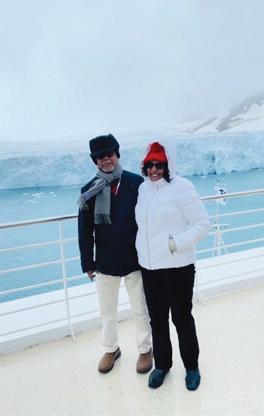
And so, we planned to set sail in January 2025, on a three-week adventure, ready to conquer the frozen frontier - armed with parkas, seasickness meds, and an unshakable determination to spot floating icebergs and penguins in real life!
We began our journey on December 31, from Boston with a layover in Houston on our way to Buenos Aires. With a 13-hour delay of our connecting flight to Buenos Aires, we rang in the New Year at the airport gate in Houston and celebrated the first few hours of 2025 with exhaustion in an overpriced hotel room.
We finally arrived in Buenos Aires



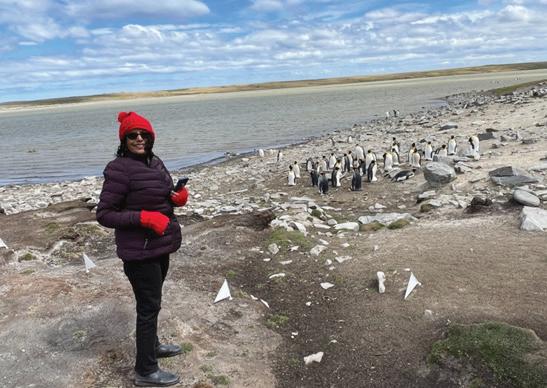

at 2:00 AM on January 2. Despite initial fatigue, we spent two restful days in the city, strolling through its charming streets, shopping, and soaking in its summer charm. But on the last day, during dinner, my blood pressure decided to take a nosedive, leading me to a dramatic emergency room visit. Luckily, I bounced back quickly, and we made a courageous decision (with fingers crossed) to go forward with the cruise.
On January 4, after a late breakfast in our hotel, we headed to the cruise terminal and reunited with Russ and Adena before boarding our floating home for the next three weeks.
The next morning, before setting sail, we kicked off our adventure with a tour of Buenos Aires city, arranged by the cruise. The highlights were a visit to the famous Recoleta Cemetery the final resting place of Argentina’s elite, including the legendary Eva Perón, and a captivating Tango show with lunch.
Leaving Buenos Aires, we sailed south for three days on the South Atlantic Ocean before entering the Strait of Magellan on our way to our first two port stops on the southern tip of South America - Punta Arenas and Ushuaia, the two gateway cities to the Antarctic Peninsula. Beyond that is the open body of water - the dreaded Drake Passage - connecting the Atlantic and Pacific Oceans to reach the Antarctic Peninsula.
Punta Arenas, Chile - a remote, yet vibrant city - is one of the two southernmost urban centers on the continent, serving as the official gateway to the Antarctica Peninsula. Sitting on the top of rolling hills and gazing over the Strait, Punta Arenas once thrived as a crucial maritime hub offering ships a natural passage between the Atlantic before the Panama Canal was built.
The highlight in this first stop was a century-old Patagonian cattle ranch where we witnessed special breed sheepdogs working with a flock of sheep, witnessed the surprisingly intense process of sheep shearing, and enjoyed a feast of locally sourced lamb barbecue.
Continuing our journey south through the Strait of Magellan and navigating several smaller passages that connect to the Beagle Channel, we arrived in Ushuaia, Argentina, the world’s official ‘southernmost city’.
This is where in a rookery - a fiveand-a-half-hour Catamaran ride away - we had our first encounter with Magellanic Penguins (Figure 1). It was fascinating to see a large group of these ‘flightless birds’ in their natural habitat – sometimes gathered in a circle, hundreds more resting peacefully on the beach, and a few playfully jumping in and out of the water. It was a moving scene of Antarctic wildlife, and a dream come true for us.
As we left Ushuaia, the ship entered the notorious Drake Passage – a